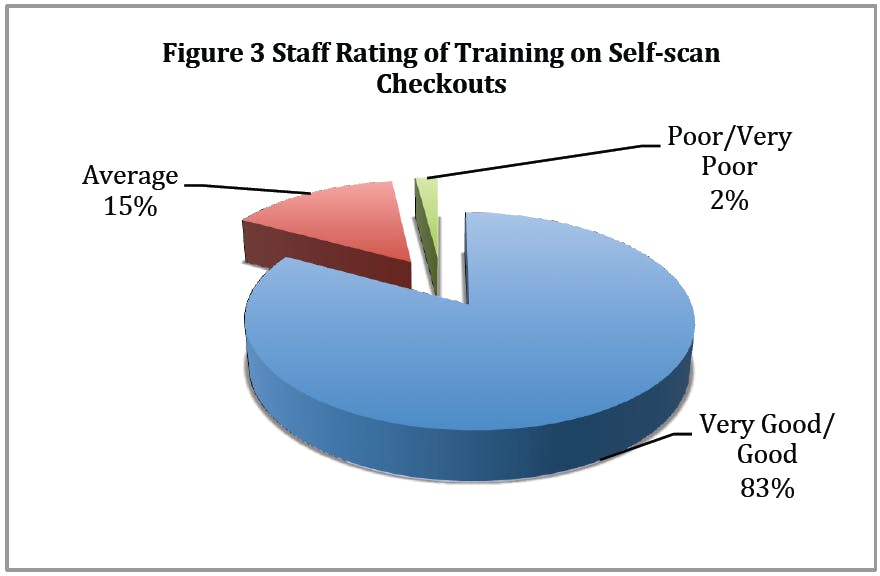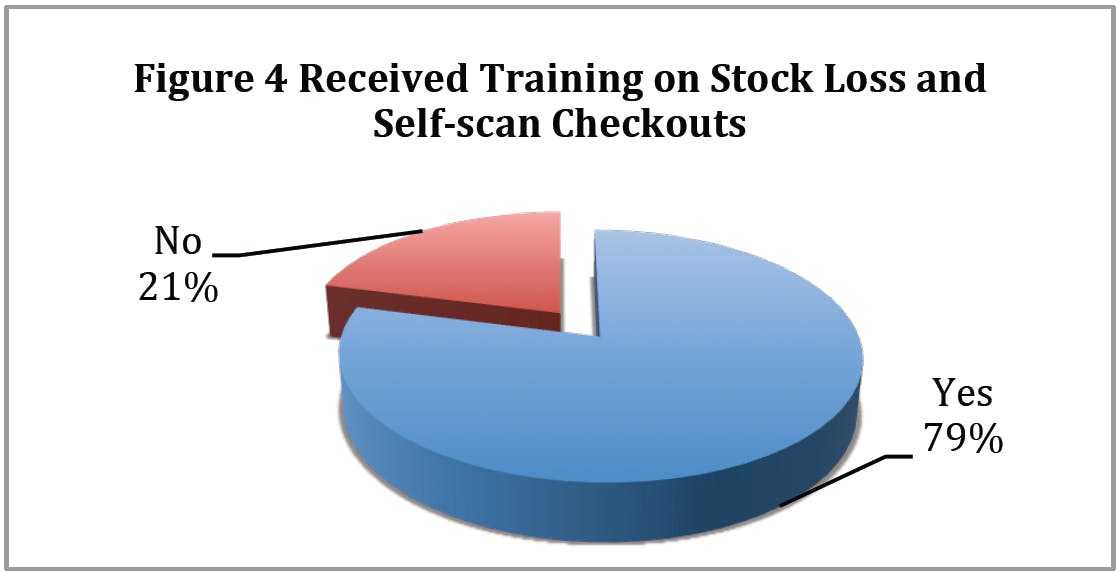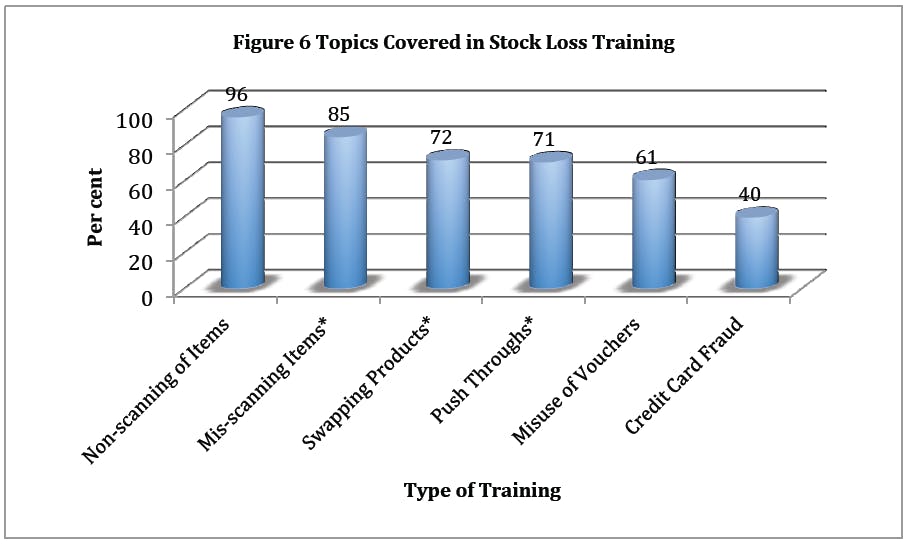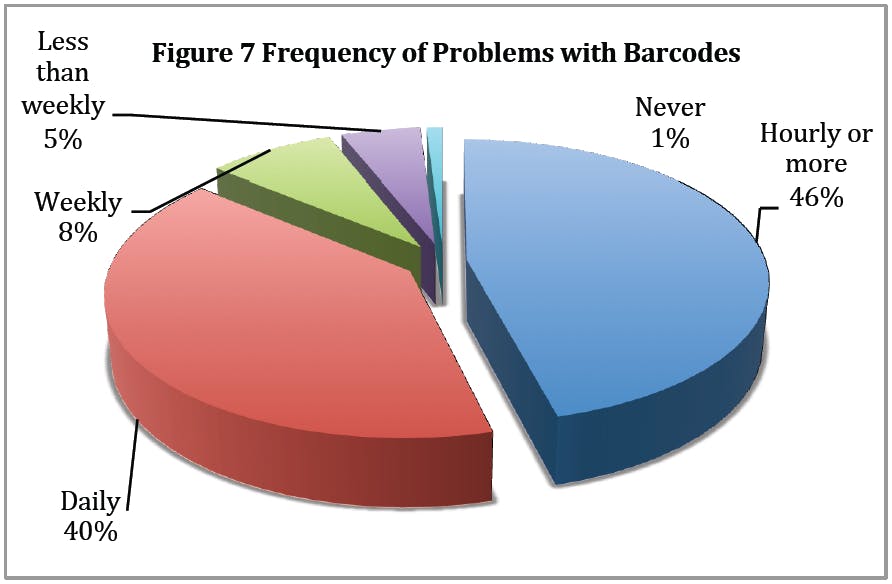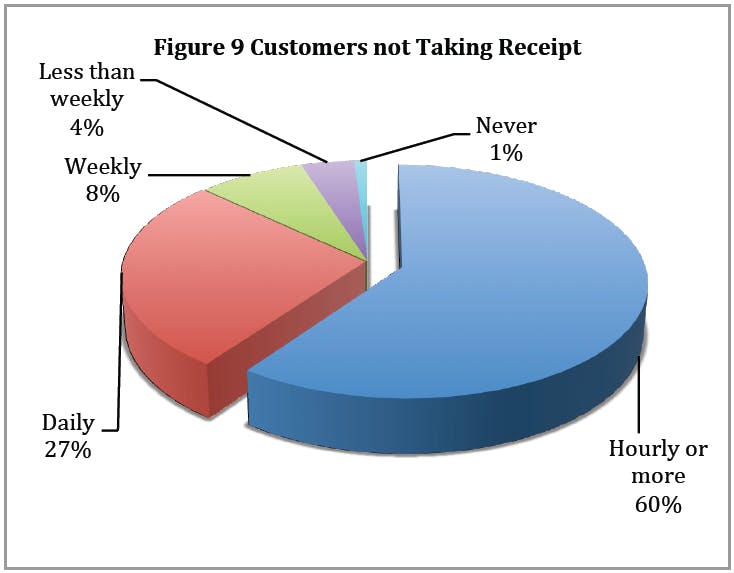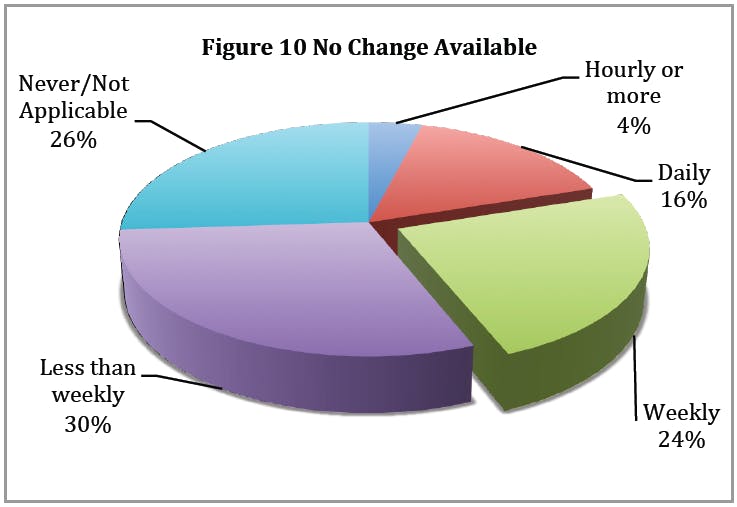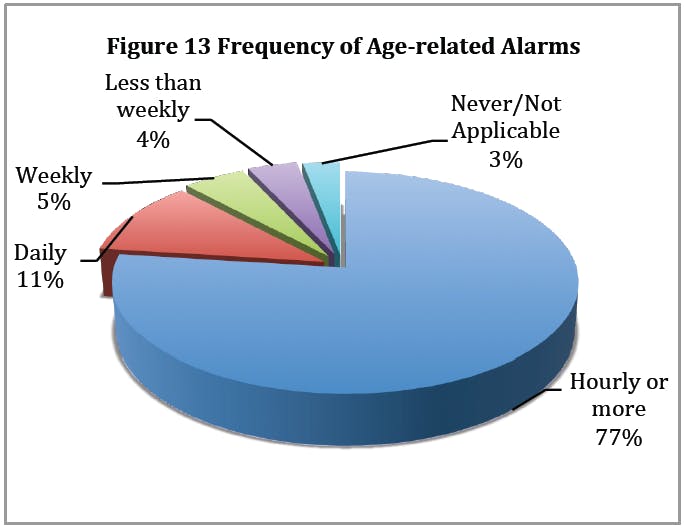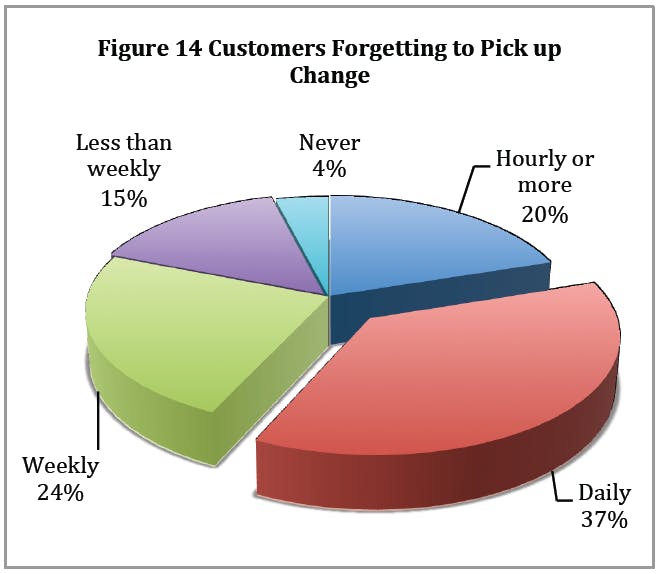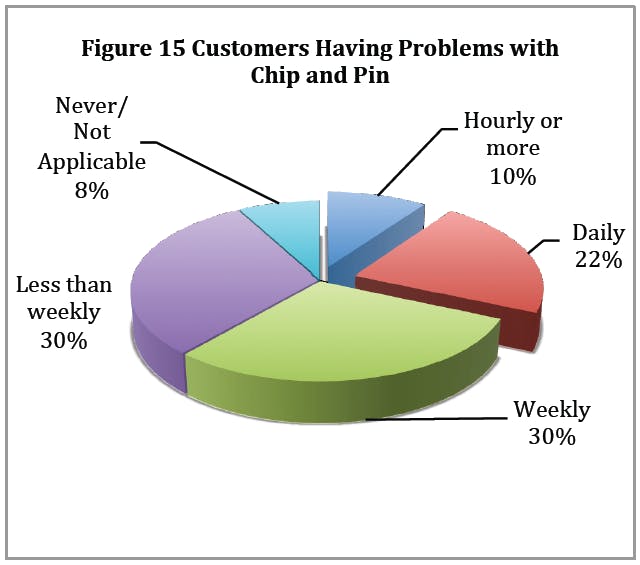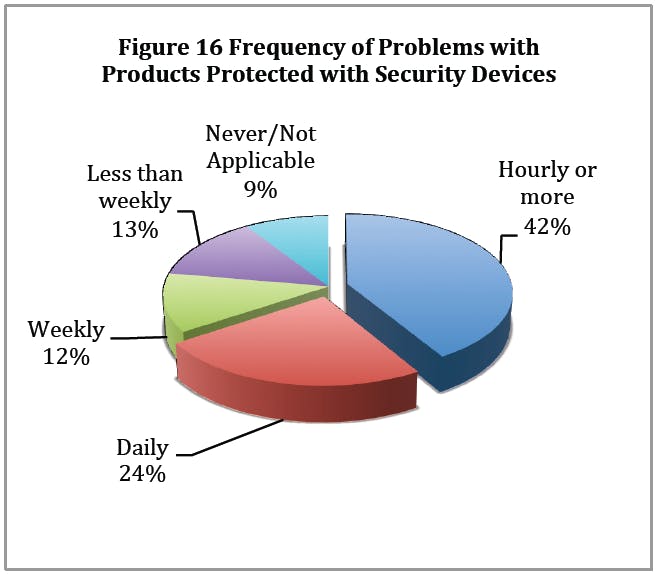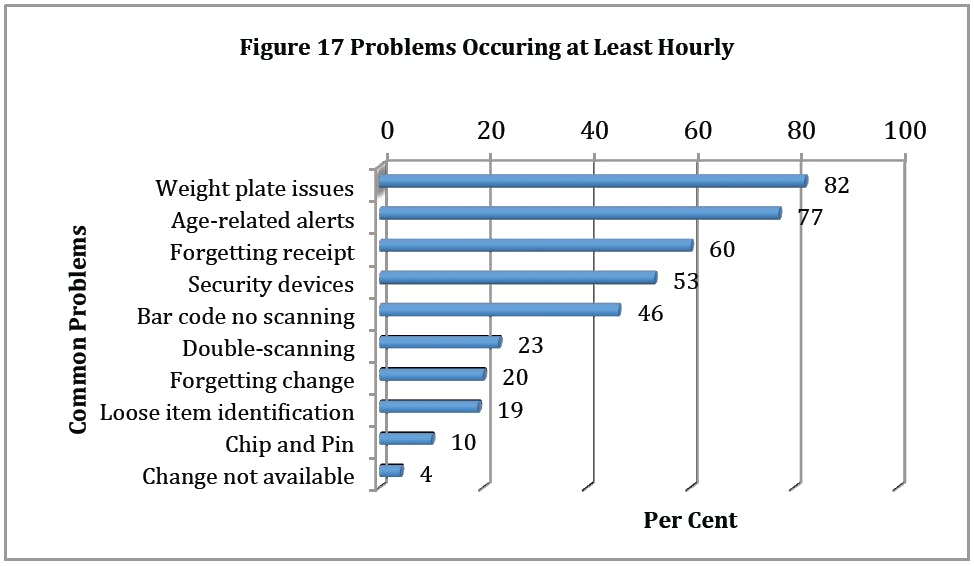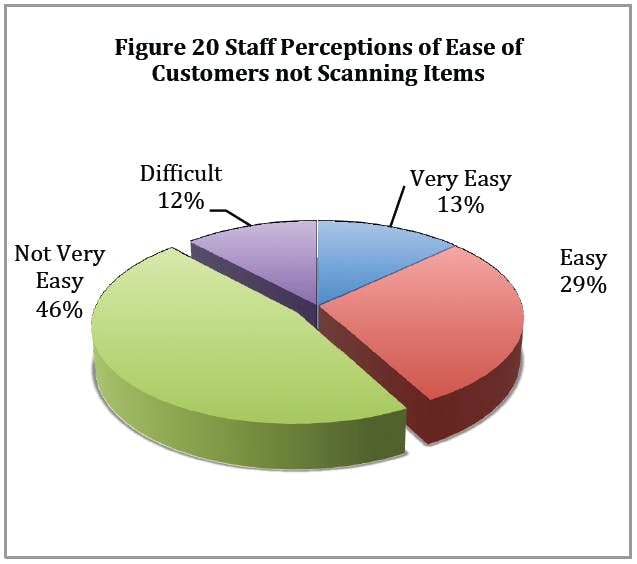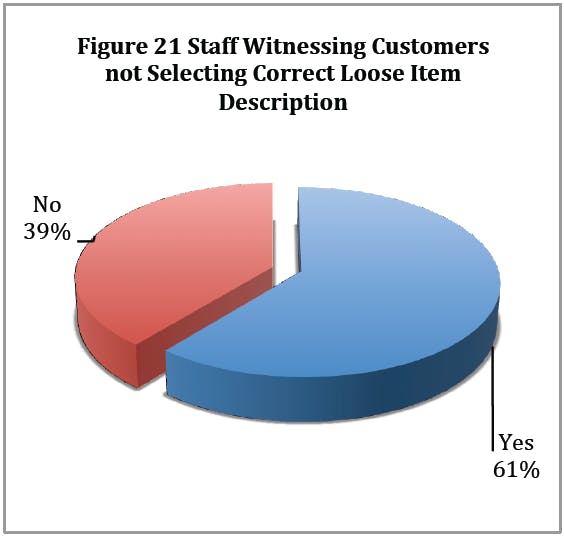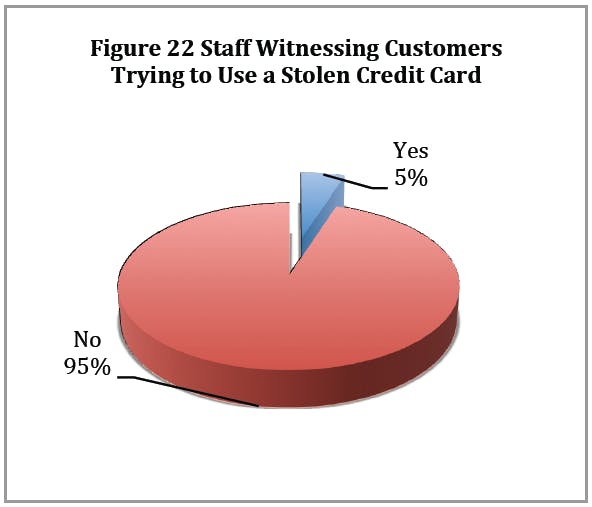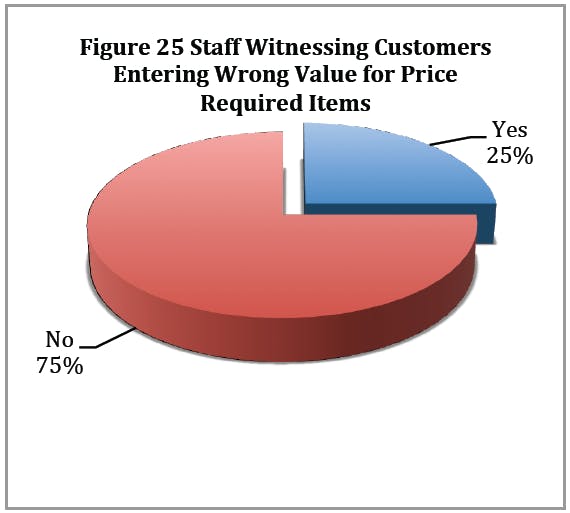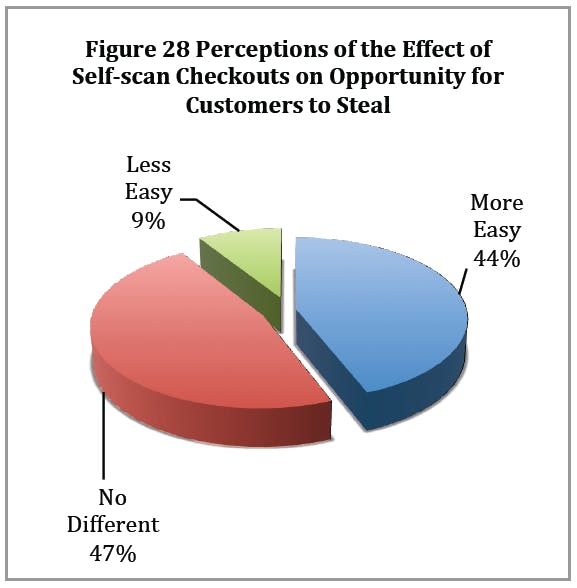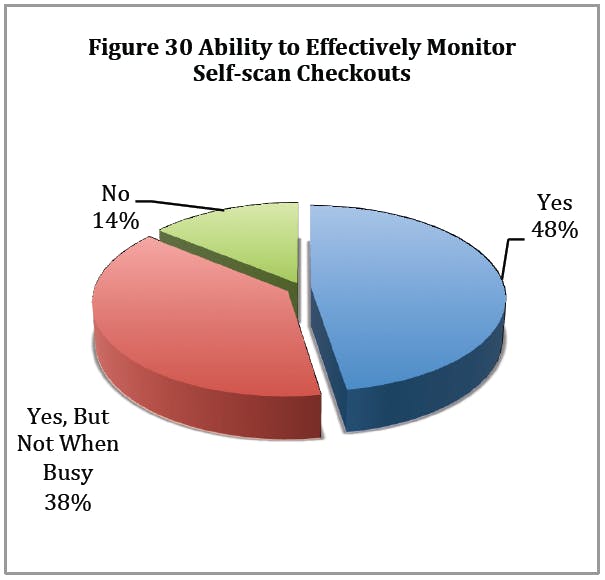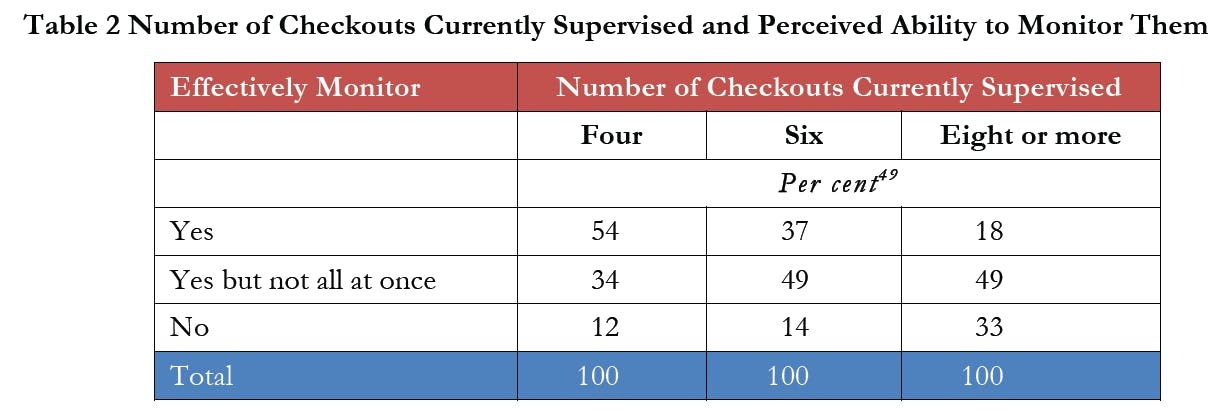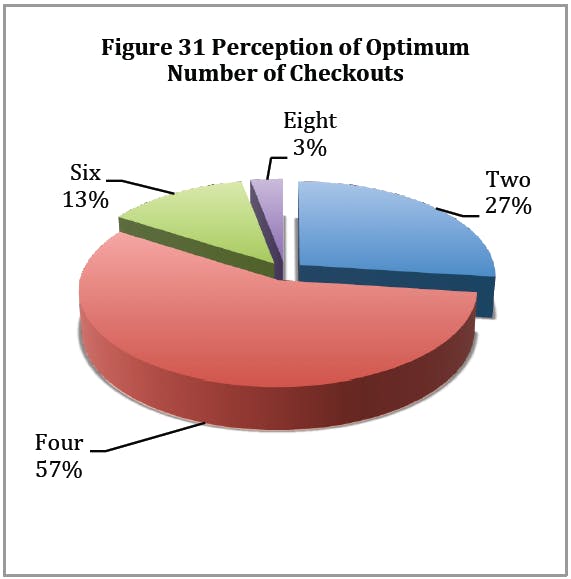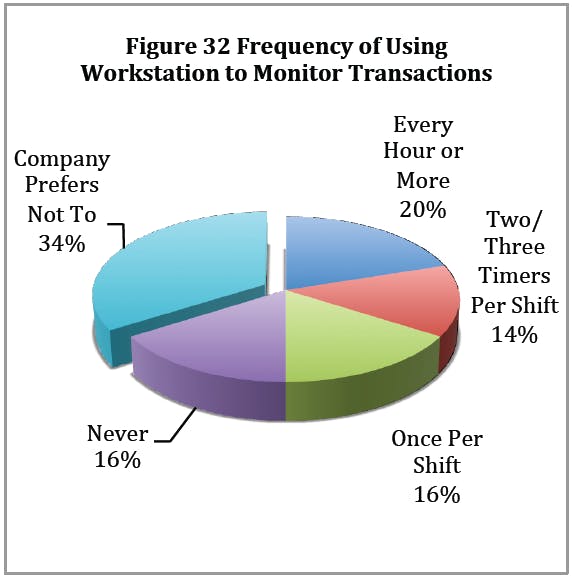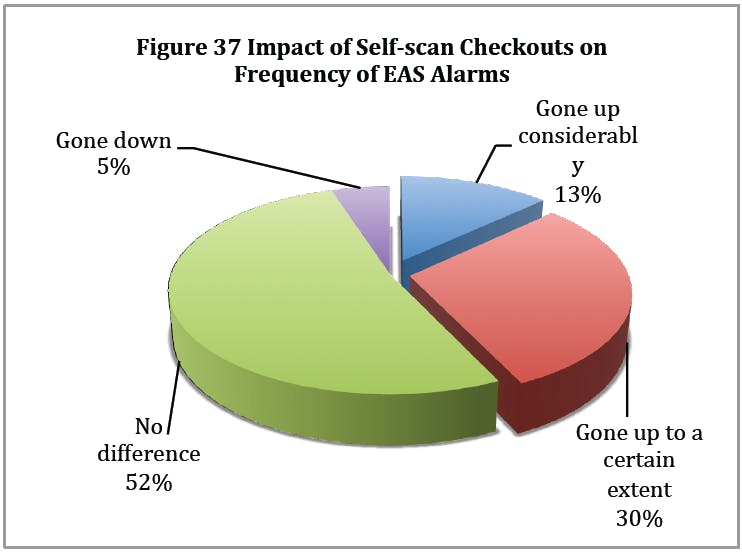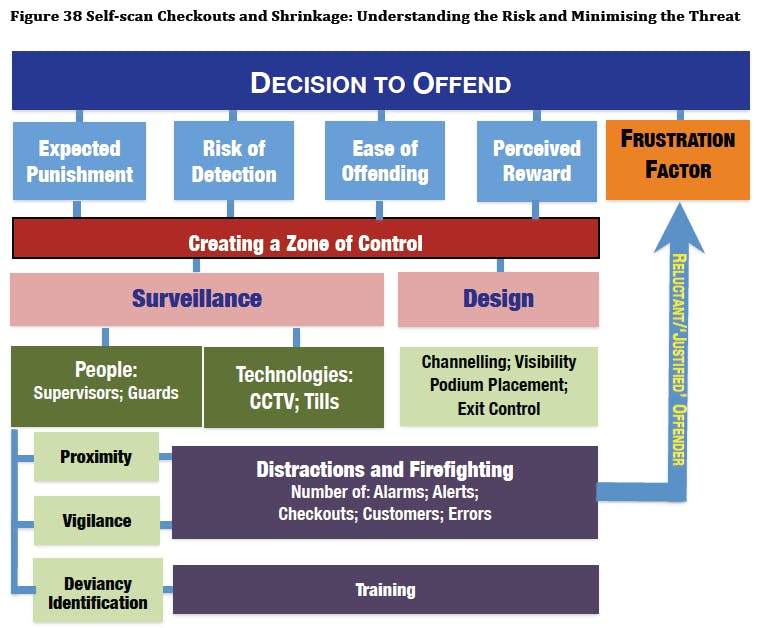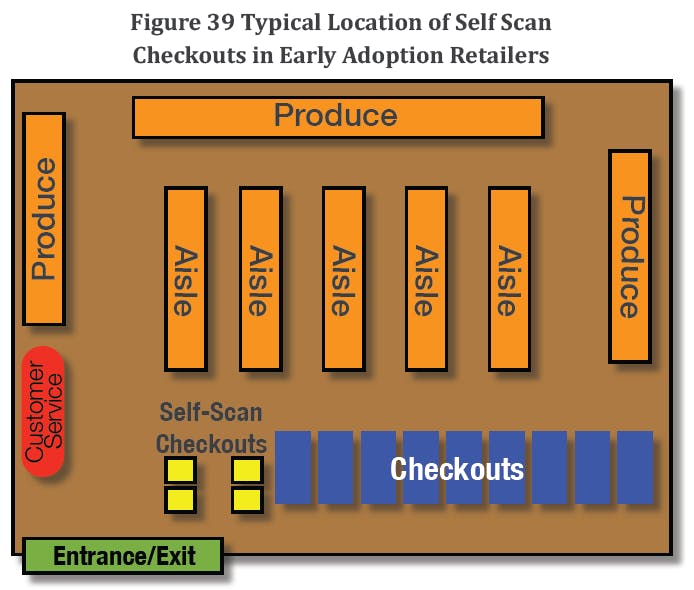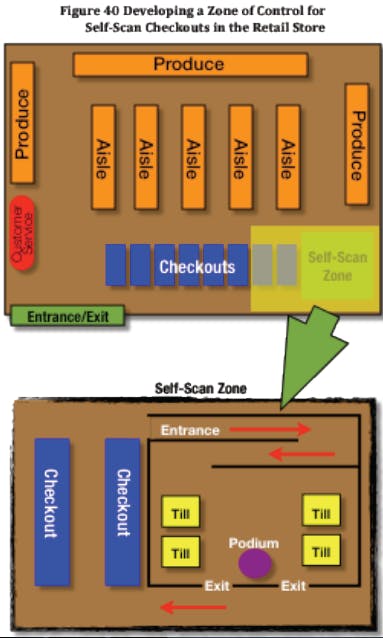The Impact and Control of Losses at the Self Checkout
Table of Contents:
- Background and Purpose
- The Use of Self-Scan Technology
- Retail Shrinkage
- Methodology
- Structure of Report
- Retailer Case Studies
- - Retailer A
- - Retailer B
- - Retailer C
- Conclusions
- Staff Perceptions of Self-scan Checkouts
- - Training Employees
- Customer Use of the System
- Abusing Self-scan Checkouts
- Maintaining Vigilance
- Self-scan Checkouts and Offending: Catching Thieves
- Discussion and Conclusions
- Surveillance and Zones of Control
- Designing Zones of Control
- The Reluctant/‘Justified Offender’
- Shrinkage and Self-scan: Future Trends?
- Recommendations: A Practical Guide to Implementing and Managing Self-scan Checkouts
- - Training Self-scan Supervisors
- - Refining the System
- - Number of Checkouts
- Creating Self-Scan Zones of Control
Executive Summary
This study, published in 2011, aimed to contribute to the debate concerning the potential impact self-scan checkouts may have on retail shrinkage.
It adopted a multi-method approach: retailer case studies, a survey of self-scan supervisors, and interviews with self-scan technology companies, loss prevention practitioners and product protection providers.
Key findings are:
- Limited evidence from the retail case studies suggested that the introduction of self-scan technologies had little or no impact on levels of shrinkage. One retailer found that manned checkouts operators are three times more likely to not scan an item than a customer using self scan.
- A survey of 955 self-scan supervisors did not identify widespread concerns about customers abusing this system, with the majority not having caught anybody stealing through this method nor suggesting that the non-scanning of items was widespread.
- The research identified the need for retailers to create ‘zones of control’ within which self-scan checkouts operate to ensure that potential thieves perceive it to be both difficult to steal and that it was highly likely that if they did offend, they would be caught.
- These zones of control should be created through careful design (where possible creating a separate self-scan space, controlling the movement of customers and limiting means of entrance and exit) and generating overt forms of surveillance (supervisors and other staff constantly being highly visible and near to customers; the use of CCTV and public view monitors and technological monitoring through till-based alerts and alarms).
- Where possible one supervisor should be responsible for a maximum of four self-scan checkouts – this maximises their ability to be vigilant and to effectively respond to customer queries and system alarms and alerts.
- Certain elements of self-scan systems should be reviewed, including:
o the number of alerts generated compared with the ability of staff to act as ‘guardians of control’; identification of products that persistently create scanning problems for customers (barcode not reading) and ameliorative action taken (either by the retailer or through negotiation with the product manufacturer); review of location of the receipt function; improved customer notification of change, including location of scoop; review of loose item description interface; and how discount vouchers are handled and verified - Training of self-scan supervisors is critical – they need to be aware of the importance of maintaining vigilance and keeping in close proximity to customers. They also need to be aware of all the well-known self-scan scams.
- The providers of product protection equipment need to work much more closely with the manufacturers of self-scan technologies to ensure that the current problems being experienced with devices such as EAS tags (false alarms because customers are not deactivating tags consistently) can be addressed.
- There is a need for further research to understand the level of losses being experienced through traditional checkouts to better understand whether the levels of loss are similar or indeed higher than those occurring through self-scan checkouts.
- There is a need for further research to understand the level of losses being experienced through traditional checkouts to better understand whether the levels of loss are similar or indeed higher than those occurring through self-scan checkouts.
Introduction
Background and Purpose
The purpose of this report is to contribute to the debate concerning the potential impact selfscan checkouts may have on retail shrinkage. Since their first introduction back in the US in 1992 they are increasingly becoming a familiar part of the modern retail space (particularly in supermarkets) and this market is seeing remarkable growth across the globe with sales expected to triple between 2007 and 2011. For some they provide another opportunity to give the consumer even greater convenience and choice coupled with an attractive return on investment (ROI) model for the retailer that potentially reduces their biggest recurrent cost – staff. For others they are seen as the start of a slippery slope towards less and less customer service adding yet further complication and irritation to the average consumers shopping experience.
Within the world of loss prevention views have been equally mixed. Some have viewed this development in horror, fearing that it introduces an enormously easy way for ‘customers’ to steal product from stores, particularly through the selective scanning of items. These doomsayers worry about the lack of control over the customer at a critical stage in the purchasing process – payment – arguing that there is relatively little to stop them simply putting some of the products in their bag without paying for them when not being actively supervised by a member of staff. However, others have argued differently, coming out in defence of the self-scan checkout revolution. Some have suggested that ‘trained’ checkout operators already regularly make errors (not scanning items) either on purpose to benefit friends and family (sweethearting) or because they are poorly motivated and or trained to do their job properly. Their argument goes that losses through this type of activity will be about the same as those caused by the customers who decide to exploit the self-scan systems or make errors. Indeed, some have gone further to suggest that customers will actually be more accurate as many will be keen to make sure they do not make a mistake when using these systems (driven by a concern not to be caught acting ‘dishonestly’) and their relatively irregular use compared with retail staff will minimise any degree of laziness/lack of attention that may be exhibited by disenchanted employees (sometimes to the point where they may end up scanning and paying for items more than once).
A third group have suggested that while shrinkage may go up due to some customers exploiting the opportunities presented by self-scan checkouts, these losses will be more than offset by the staff savings that accrue through their introduction – typically a bank of between four and six self-scan checkouts will be monitored by just one member of staff and take up the equivalent space of two typical checkout lanes. While costing more to purchase in the first instance, selfscan checkouts, the argument goes, present a very persuasive business model, particularly if their impact on shrinkage is either neutral or even slightly negative. This argument is further bolstered by the manufacturers of the technology who claim that the checks and balances they have designed into their systems, such as product weight confirmation plates, limit the opportunities for theft to take place and therefore make the business model even more persuasive.
While there is a considerable amount of research and published material in the public domain focusing on the various ways self-scan technologies can be utilised, their benefits, known operating problems and realisable ROI, there is virtually nothing published of any note on their relationship with shrinkage. Numerous public sources reference a 1995 report by NCR (one of the main providers of self-scan technology) on shrinkage which apparently suggested that this technology actually reduced shrinkage losses, but it has proven to be an illusive document to uncover and the researcher has failed to track it down (one of the retailers that was apparently consulted for the report was contacted but they could only say that they did not provide any evidence to support the view that self-scan checkouts were associated with lower levels of shrinkage). Another report, again by a self-scan technology provider (IBM), makes a similar statement: ‘Research has found, however, that shrink is often either the same or less in self checkout lanes…’, but the report does not go on to explain where or how this research was undertaken.
There is evidence from some unpublished research, undertaken by Evans and Deyle in the US on the potential impact of self-scan checkouts on shrinkage, which was presented at the RILA Auditing and Safety Conference in Orlando Florida in 2009. This study was based upon a perception survey of six retailers together with an analysis of shrinkage data from a ‘Sub section of 39 retailer share group which accounts for $259 billion in annual sales’ (sic) on differences in shrinkage between stores with and without self-scan checkouts. While the results from the survey of six retailers is of limited value due to the size of the sample, the data presented from the 39 retailers offers some interesting insights10. They concluded that inventory shrinkage was ‘slightly higher’ in stores with self-scan checkouts compared with stores that did not employ this
technology. They went on to say that ‘external theft activity’ in self-scan stores was between 20 per cent and 65 per cent higher and ‘inventory shrink in theft-related items’ was approximately 20 basis points higher. Also of interest was their conclusion that the rate of EAS alarms was 28 per cent higher in self-scan stores compared with stores not using this technology.
The only other sources of publicly available information on shrinkage and self-scan checkouts have been sporadic mentions in the media, typical of which is a piece in the 2007 edition of Supply Chain Digest entitled ‘Retail Supply Chain: Shrinkage Causes Wal-Mart to Adjust SelfService Process’, which noted how some Wal-Mart managers in the US had noticed ‘an unbelievable increase in shoplifting’ due to the introduction of self-scan checkouts, although they were using a system which did not weight check items. However, none make reference to any verifiable data that can confirm the impact, if any of self-scan systems on rates of shrinkage.
Given this lack of clarity on the issue and the increasing speed with which many retailers around the world are introducing this technology, the ECR Europe Shrinkage Group decided to commission this piece of research. The aim of this study was to try and contribute to this debate on what impact if any self-scan checkouts might have on shrinkage in the retail sector. In particular it was proposed to try and develop, if possible, a series of guidelines on how to minimise the risk of shrinkage when introducing self-scan checkouts and also explore the implications of their use on product protection technologies used in-store such as Electronic Article Surveillance (EAS) tags. It is worth highlighting that this study is only interested in self-scan checkouts and not other variants of self-scanning technology that currently exist. To clarify, in this study self-scan checkouts refer to systems whereby customers use a checkout machine to scan items they have selected from the store themselves, including selecting categories for loose items (such as fruit and vegetables), and make payment via cash or a credit/debit card. This may also include some functionality to deactivate Electronic Article Surveillance (EAS) tags. For all the retailers taking part in this study, there was no process for carrying out a post-scan audit of a customer’s purchases to verify accuracy.
The Use of Self-Scan Technology
The concept of getting customers to perform more and more of the tasks that make up the shopping experience is not new. Back in the early parts of the last century supermarkets began moving away from a system whereby all the goods in a store were held behind counters accessible only by asking a member of staff for assistance to the now familiar concept of self-service, with goods being on open display. Customers were now free to select the goods they wanted (and browse goods they might be interested in) and only interact with a member of staff when they wanted to pay (with the associated development of the checkout station). A similar change can be seen in the way in which petrol stations now increasingly operate where there is an expectation that the customer will take responsibility for using the refilling equipment themselves and then pay at the end. Equally, the rise of the ATM machine has seen a remarkable change in the way in which people now gain access to cash from banks – they are no longer required to present themselves at a bank at proscribed times but instead can use a widely available technology at their own convenience. This changing model of business is considered a win win development – the provider reduces costs (you need less staff to serve) and the consumer is given greater freedom to access a broader ranges of goods and services at their convenience. Self-scan checkouts are a logical extension of this process.
There are essentially two main types of self-scan system: Stationary Self Service Checkouts and Portable Self Service Platforms. The former is a fixed device where customers bring their goods, scan them and arrange payment themselves. The latter is a hand held device whereby the customer scans goods as they move around the store and then when ready to pay approach a designated member of staff with the device that is then used to arrange payment. There is considerable variance in the way each of these systems are designed and developed by the technology providers and operated by the retailers using them. For instance, some retailers insist upon the use of random audit checks whereby every nth customer is selected to have their shopping checked by a member of staff. This is seen by some as a valuable means of generating deterrence as the random element of the process makes all those using the system aware that they could be checked at any time. For other retailers this is regarded as too time consuming, preferring to rely upon other means to reduce the likelihood of customers stealing goods through self-scan checkouts.
Early adopters of this technology have primarily been large volume retailers such as supermarkets, hypermarkets and DIY type retailers, although the technology providers claim that it can work in most retail environments. With approximately 80 per cent of supermarket labour costs being incurred at the checkout, it is perhaps not surprising that this environment has been an early adopter – any innovation that can make an inroad into this cost is likely to be taken seriously. In addition, surveys have shown that while it can be slower to use a self-scan checkout than a manned checkout, customers think it is faster (due to the lack of queues and the act of doing it yourself) and about 50 per cent suggest they like the choice of different ways to check out. While few Return on Investment (ROI) studies have been published, manufacturers of the technology suggest that adopters can realise a profit in about 1-2 years or less.
Retail Shrinkage
Before going on to discuss the methodology used and the limitations of this study, it is worth providing a brief summary of the problem of shrinkage as it affects the retail sector. The subject of ‘shrinkage’ or ‘shortage’ as some prefer to call it is a difficult subject to get conclusive information about – companies rarely publish or share shrinkage results. Most available information on the scale and extent of the problem come from various surveys that are undertaken across the globe. Beck and Peacock recently brought the available data together and concluded that globally shrinkage is costing the industry $278 billion a year or 1.65 per cent of retail turnover – figures which ignore the additional cost of lost sales due to shrinkage-created out of stocks (estimated at a further 0.2% of retailer turnover). When this is related to the overall impact on retail sales, they suggest that if the cost of shrinkage could be halved, then most retailers would see their profits grow by 36 per cent.
Traditionally the key cause of shrinkage has been seen to be external thieves although globally estimates vary considerably on the proportion of loss accounted for by them. For instance the annual surveys undertaken by the University of Florida regularly conclude that internal theft makes up the biggest proportion of loss while the various Global Retail Theft Barometer surveys suggest that external theft is the largest single contributor. If an average is taken across the various recent surveys then it would seem to be that external theft accounts for 35 per cent, internal theft 33 per cent, with process failure and inter-company fraud making up the remaining 32 per cent.
What is unclear from any of the existing literature on retail shrinkage is the extent to which losses at the checkout contribute to overall loss – it is an unknown figure although numerous practitioners have speculated on how significant it might be, to the point of investing in a wide range of technologies to try and detect and deter its occurrence. Certainly the available research on staff dishonesty would suggest that the checkout provides an attractive opportunity for deviant behaviour – it is difficult to monitor (certainly in terms of non-technological identification of non-scanning) and brings employees into regular contact with the hottest product of all – cash. An earlier study by ECR Europe identified the extent to which dishonest employees found it relatively easy to steal from the checkout, which supports to a degree the earlier hypothesis that customers using self-scan checkouts will steal and or make errors at about the same rate as employees – therefore overall rates of shrinkage will not be affected. What is required, however, is more detailed research which quantifies the actual level of losses occurring at manned-checkouts compared with other areas where losses occur, such as by external thieves stealing products, members of staff doing the same, and the whole panoply of losses relating to process failures. Until this is achieved, then it will not be possible to confirm whether customers do indeed steal and make errors at about the same rate as members of staff.
Methodology
At the outset, it was proposed to use a number of different methodologies to try and achieve the aims of this study, including: retailers acting as case studies to try and provide data on the impact the introduction of this technology had had on levels of shrinkage in their companies; a survey of self-scan supervisors to find out their experiences of these systems; interviews with various technology providers (both self-scan systems and those who provide product protection equipment); and interviews with loss prevention practitioners. This wide range of methods was used because it was not clear at the beginning what information if any would be available from retailers themselves on the actual impact on shrinkage of these systems – this sort of data is
notoriously unreliable when trying to measure relatively nuanced changes to retail spaces. More often than not, retail shrinkage numbers are based upon relatively unsophisticated modes of measurement – annual store audits being an example where some losses will not be identified for up to 12 months after they have happened making it impossible to ascertain the cause of the loss.
In addition, in the periods when self-scan systems have been introduced into retail stores there are often a range of other changes that have occurred at the same time (such as other retail systems being introduced, changes in store layout, product ranges, types of product protection used etc), many of which are virtually impossible to isolate within the overall shrinkage data. Therefore while retailers may record changes to shrinkage data that in the first instance are correlated with the introduction of self-scan technologies, there is a significant difference between correlation and causation – the former measures similarity, the latter explains why one factor affects another. In the dynamic and fast changing world of modern retailing, trying to undertake ‘experiments’ to test for causal changes when new technologies or approaches are introduced is notoriously difficult, and in this instance, it is further compounded by the relatively unsophisticated nature of the main variable – the rate of shrinkage. So while the retailer case study data was seen as a potentially important way of trying to understand the impact of self-scan technology on shrinkage, other approaches were also adopted to generate different types of data that could also help to meet the objectives, although by their nature, they inevitably become more indirect and require a greater deal of interpretation.
Retailer Case Studies
Four retailers agreed to act as main case studies for the first part of the study. All of them were UK-based and together represented a significant proportion of the supermarket sector. Each had introduced self-scan at different times, in different ways, across a range of store formats, and at different speeds of roll out. One retailer had had experience of a different form of self-scan system in the past – hand held barcode readers that enabled customers to scan as they moved around the store and then at the end of their shopping they presented the device to a member of staff who organised payment.
Each company was contacted with a request for specific information relating to shrinkage and the introduction of self-scan checkouts, in particular: whether they could identify a group of stores (40) that previously had not had self-scan and then had had it introduced approximately 12 months previously. The idea was to try and measure changes in shrinkage over time as these stores moved from not having the technology to then having it installed. In addition, the retailers were requested to identify a group of stores that matched the profile of those that had self-scan introduced to act as a control group. This exercise proved very difficult for the companies to do with any degree of accuracy. In the end just one retailer was able to provide any form of data that came close to this requirement. The results from this are presented in the next section. For the others, they were simply not able to either provide the historic data with any accuracy or identify sufficient stores where the transition could be readily ascertained. For one of the companies agreeing to take part, the introduction of self-scan checkouts coincided with the introduction of a home delivery service in the same stores, making it impossible to know whether any changes in shrinkage were due to self-scan, home delivery or a combination of the two.
In addition to the main case study companies, a US retailer also agreed to make data available to aid the study. This company used a relatively new and innovative technology that enables the rate of non-scanning at the checkout to be monitored (along with other forms of deception and mistakes). The retailer was able to provide the rate of non-scanning for manned checkouts compared with self scan checkouts for a 12-month period covering 47 stores, which included 554 manned registers and 63 self scan registers. Of itself, this is groundbreaking data as prior to this it had been virtually impossible to monitor error rates at the checkout on such a scale. However, it does only measure one aspect of malicious and non-malicious activity at checkouts and so the data needs to be used cautiously. For instance, non-scanning at self scan checkout is not the only one way in which thieves can steal products – they can scan product and then simply not pay, they can use incorrect product identification codes for weighed items, and so on. Neither of these scams would be captured by this data. Given that, it is still some of the strongest published data enabling a comparison to be drawn between rates of non-scanning at manned and self scan checkouts.
Survey of Self-Scan Checkout Supervisors
Because it was predicted that shrinkage-based data from case study companies was likely to be unforthcoming with any degree of accuracy, it was decided to undertake a survey of those staff that had responsibility for monitoring the checkouts on a regular basis. Given their role, it was felt that their insights to the way in which the tills were operating, the problems they encountered and the ways in which customers were using and abusing them, would generate some valuable data. Once again, only UK-based retailers were used to collect the data. The responses came from 6 UK retailers with a combined retail turnover of €94.5 billion, representing 52.5 per cent of the grocery market. The data was collected in two main ways. Four companies agreed to collect the data within their own businesses by distributing a self-complete questionnaire to stores where self-scan was in operation. Those selected were simply available at the time of data collection in those particular stores – no effort was made to stratify the sample within each of the companies adopting this approach. All four companies selected stores across the UK for inclusion. The data from the two remaining retailers was collected by a third-party company that visited their stores on a regular basis for the purposes of merchandising. The stores were selected based upon the rota drawn up by the third-party company for a given month and covered all of England, Scotland and Wales (the researcher identified those stores that had self-scan from lists provided by the retailers). Upon entering the store the representative went to see the store manager and requested that one member of staff who was currently not working on self-scan checkouts (but usually had responsibility for them) completed a questionnaire. Once completed, the questionnaire was returned to the representative who then forwarded it to the researcher.
A total of 978 questionnaires were eventually returned through the two methods, of which 955 were ultimately usable. Given the way in which the data was collected, some caution has to be exercised concerning how representative the sample actually is of those working as self-scan supervisors – the researcher was not able to dictate the precise methods with which the respondents were selected and therefore there is a possibility of systematic skewing of the data by the companies that collected the information. However, the relatively large sample size and the fact that it was collected across six retailers offers some degree of assurance that the results have a relatively high degree of integrity and representativeness of those who have responsibility for supervising self-scan checkouts in the UK supermarket business.
Interviews with Practitioners and Technology Providers
The final methodology adopted was semi-structured interviews with a series of representatives from the loss prevention industry, those that provide the self-scan technology and product protection technology providers. They were approached through contacts made through the ECR Europe Shrinkage Group and while their views are not brought together into a separate section in this report, their impressions and thoughts are utilised throughout this document to aid analysis and interpretation. For the sake of anonymity, none of those interviewed will be identified.
Structure of Report
This report is made up of 4 sections. The first documents the available but limited data from the case study retailers. The second presents the detailed findings from the survey of self-scan supervisors. This is then followed by a discussion/conclusion section that brings together the key findings from this study and how self-scan technologies can be understood within the broader context of shrinkage management. The final section then makes a series of recommendations for how self-scan checkouts can be utilised to minimise their impact upon shrinkage.
Retailer Case Studies
Only two of the four retailers that agreed to act as main case study retailers were able to provide any data that was in someway useable for the purpose of this study. Of those, the first (Retailer A) has the most reliable and verifiable data that stands up to any form of critique. However, overall, this part of the study did not prove a great success in terms of generating good quality shrinkage data to establish what impact if any self-scan checkouts have on rates of store shrinkage. The data from the US company employing a technology to identity non scanning at checkout did prove more successful and the data presented below is extremely interesting in terms of understanding the risks associated with traditional and self-scan checkouts.
Retailer A
This is one of the largest supermarket retailers in the UK with 500+ stores now using self-scan checkouts. They were not able/willing to provide the data as requested by the researcher, but did provide access to an independent study they had commissioned one year prior to this study to explore the potential impact of self-scan on shrinkage. It should be noted that the available report does not give any significant detail on the methodology adopted but does follow a number of reliable methodological steps that make the data of some value. The company looked at a sample of 66 critical security risk stores (with varying formats) that had self-scan checkouts and compared them with 38 stores (with the same rating) that did not have this technology. The data was collected over a 12-month period. It is not clear why the control sample is that much smaller than the self-scan sample or whether the stores were matched pairs (although the data is compared by format type).
As can be seen from Table 1, the difference between the two samples was 3 basis points and was not statistically significant – suggesting that self-scan had no noticeable impact upon shrinkage. This is particularly interesting data as it came from high risk stores – an environment that many loss prevention practitioners have voiced concerns about the appropriateness of introducing selfscan checkouts.
The company then looked at a sample of 27 stores where self-scan had been installed and compared shrinkage data 12 weeks prior to installation and 12 weeks post installation (Table 2).
Across the sample, the change in the rate of shrinkage was almost the same as that found across the entire company (there was no statistically significant difference). Once again they concluded that self-scan had no discernible negative impact upon shrinkage in those stores utilising this technology – it was impact neutral in terms of loss.
Retailer B
This retailer has a national presence with over 600 stores that provide a mixed retail space including a strong food component. They were able to provide some very limited data on the impact of self-scan checkouts in their retail estate. It should be noted, however, that this company has struggled in the past to provide accurate and detailed information on shrinkage and so its results need to be treated with a considerable degree of caution. They were able to provide analysis of six stores where they were able to collect before and after data. One of the stores had to be removed as their starting point for shrinkage was significantly and dramatically lower than any of the other stores and adversely skewed the results. For the remaining 5 stores, the data showed a 20 basis point increase in shrinkage between stores with self-scan checkouts and those without. This is the same as result as found in the Evans and Deyle study in the US. However, the sample here is much smaller and method of store selection is not known and so extreme caution needs to be exercised with these results.
Retailer C
This US retailer has about 60 stores in Massachusetts and Connecticut, a turnover of $1.2 billion and offers a typical range of products found in most supermarket chains. More unusually, it has invested in a technology that enables it to monitor the performance of checkout operators using a system that links CCTV with the EPOS system and through the use of software and human monitoring, can identify a range of malicious and non-malicious activity. The company agreed to provide data comparing the rate of non-scanning at manned checkouts compared with self scan checkouts. As detailed in the methodology section earlier, it covers a 12-month period across 46 stores and 554 manned tills and 63 self scan checkouts. It is worth reiterating that this data only covers the non scanning of items and does not include other forms of malicious activity that can be found at self scan checkouts, such as scanning but not paying and using the wrong product code for loose items. Detailed in Table 3 below is the data comparing manned and self scan checkouts for the rate of non scanning of items.
As can be see, out of over 425 million items moving through manned checkouts, nearly 30,000 were not scanned giving an error rate of 0.007%. For self scan checkouts, some 23 million items were moved with only 554 apparently not being scanned by the consumer, giving an error rate of 0.002%. While the volumes are considerably different the variance in error rates is profound and dramatic – in terms of non scanning, staff are three times more likely to do it than customers in this retail environment. This data is instructive for a number of reasons. First, it suggests that customers are potentially more assiduous in their efforts to scan items than store staff, perhaps driven by a combination of honesty and fear but also novelty and relative infrequency of having to do this task. For staff, routinisation, apathy, indifference and low morale could mean they are more inclined to make mistakes or act dishonestly on behalf of friends and family (sweethearting). Secondly, it suggests that customers are not using non-scanning as a regular means to defraud the company – the number of non-scanned items captured by the system is very small with a total value of approximately $2,500. This is not to say that other methods are not being employed by customers to steal via self scan checkouts, but the premise put forward by some that customers would not scan to steal items is largely disproven by this data. Thirdly, the data shows the opportunities for improving performance at manned checkouts through the monitoring of transaction data such as this. What the retailer has found is that the vast majority of non scanning activities uncovered by this system are non malicious, caused by defective bar codes and product identification, and poor staff performance (staff simply being lazy).
Conclusions
It is difficult to draw any firm conclusions from this part of the study – the ability of the main retail case study companies that agreed to participate in this study to provide verifiable and reliable data on the actual impact upon shrinkage of introducing self-scan checkouts is largely missing. In reality only one was able to come close to providing the sort of data requested by the researcher and this showed that the impact upon shrinkage of introducing self-scan checkouts was neutral – there was neither a significant increase nor decrease in shrinkage. This is slightly at odds with the only other study currently available – the Evans and Deyle research in the US, which found a slight increase in shrinkage. The analysis of the rate of non-scanning in the US case study is more clear cut, if based upon only a sample of one. There was no evidence of wide scale non-scanning by customers and indeed, customers seem to be much more reliable than members of staff operating manned checkouts in this respect. While there are other ways in which self-scan systems can be abused by customers, which is not captured by this data, initial industry concerns about customers deciding not to scan items would seem to be misplaced at this time.
Staff Perceptions of Self-scan Checkouts
This part of the report is based upon a survey of retail employees who have responsibility for supervising self-scan checkouts. The responses come from 6 UK retailers with a combined retail turnover of €94.5 billion, representing 52.5 per cent of the grocery market. As detailed in the earlier methodology section, a total of 955 responses were received from the 6 retailers, making this the largest survey of self-scan supervisors to date anywhere in the world. The purpose of the survey was to collect information on the following areas:
- The nature, extent and value of training provided by retailers on self-scan checkout.
- Employee experiences of customers having difficulty with the system.
- The extent to which employees had witnessed customers abusing the system.
- Perceptions of the extent to which self-scan checkouts had affected the likelihood for employee and customer dishonesty to occur.
- Employee perceptions of managing the system and maintaining vigilance.
- The impact of self-scan checkouts on product security devices.
Above all, the survey was designed to try and shed further light on the potential impact self-scan checkouts may have on retail shrinkage. To ensure anonymity, none of the company data will be provided separately – all will be in aggregate form.
Training Employees
The first series of questions related to the training that employees had received on how to use self-scan checkouts. In shrinkage terms this is important because unless employees are fully cognisant with how these systems operate, and indeed the potential ways in which deviant customers and staff could manipulate them to facilitate the theft of goods, then they are unlikely to be able to manage them effectively and minimise any potential losses. A series of questions were asked focussing first of all on whether they had received general training on self-scan checkouts and what they thought of this training. This was then followed by more specific questions on the training they may have received relating to self-scan and shrinkage, focussing particularly upon the areas covered and their perceptions of the value of this training.
Received Training on Supervising Self-scan Checkouts
The first question asked respondents whether they had received any training on using selfscan checkouts. As can be seen from Figure 1, the vast majority had received some form of training (93%), with only a small minority not receiving any (7%). Only one of the retailers had a rate below 90 per cent clearly indicating that training on self-scan checkouts was being delivered to the vast majority of staff tasked with operating and managing these devices.
Length of Training
Respondents who had received training were then asked to indicate how long it had lasted with the options ranging from half a day through to more than two days (Figure 2)
As can be seen, the length of training varied considerably and there was no one time period that generated a majority response. Just over one third suggested that their training lasted half a day (34%), with just under one third stating it had lasted two days (32%). But there was also a sizeable proportion that said their training on how to use self-scan checkouts had lasted one day (22%). For the most part, very few staff (12%) had received training for more than two days.
It is interesting to note that across 5 of the 6 retailers there was considerable variation within particular sub samples, so for instance, one retailer had 39 per cent of their respondents saying they had received half a day of training, with a further 20 per cent indicating they had received a one-day training course, 29 per cent stating it lasted two days and the final 12 per cent suggesting it had been more than 2 days long. This suggests that while training on using self-scan checkouts is for the most part being delivered to staff it is not being done consistently across the majority of retailers taking part in this survey and indeed there is much variation within particular retailers.
Rating of Training
For those that had received some form of training on using self-scan checkouts, they were then asked to indicate what they thought of the training they had received, ranging from very good to poor (Figure 3).
Most respondents were of the view that their general training on using self-scan checkout had been good or very good (83%), with only a small proportion thinking it was average (15%) or poor or very poor (2%).
In terms of differences between the length of training received and the perceived value, the sample was unanimous – all of those that rated their training as poor or very poor had received half a day of training (although there were others who had received half a day of training that had rated it as good or very good). There was one retailer whose score was significantly different from the others, achieving a ‘very good/good’ rating from 62 per cent compared with an average of 83 per cent for the other five companies taking part in the survey. Overall, the vast majority of those getting training on using self-scan checkouts were satisfied with what they received.
Training and Stock Loss
The survey then went on to ask respondents whether they had received training on issues relating to self-scan checkouts and potential theft and stock loss (Figure 4).
As can be seen, compared with those that said they had received general training on how to use self-scan checkouts (93%), far fewer said that their training had included anything on potential theft and stock loss; just 79 per cent. However, of the six retailers taking part, two were at the extremes – one had a rate of non-training on stock loss issues of 46 per cent while the other had a rate of just 11 per cent. For the remaining retailers their rate of non-training was 23 per cent. Allowing for these inter-sample fluctuations, the number of those claiming not to have received training on shrinkage issues was significant – approximately one-fifth of the sample. Perhaps not surprisingly, there was a strong positive correlation between the length of training received and the likelihood it contained information on theft and stock loss issues – the longer the training the more probable it was that it would provide information on stock loss issues. For those who received just half a day of training, nearly 40 per cent said that they had not had any training relating to loss prevention and self-scan checkouts, while the failure rate for those who had a full day of training dropped to 15 per cent and for those receiving more than a day of training it was approximately 10 per cent. It would seem that less than a full day of training does not provide sufficient time to cover all aspects of supervising self-scan checkouts (including loss prevention).
Rating of Stock Loss Training
The respondents whose training had covered issues of theft and stock loss were then asked to comment upon how well these issues had been covered, ranging from ‘very well’, ‘quite well’, ‘not well’ and ‘not well at all’ (for the purpose of simplifying the presentation of the data, the categories have been collapsed into just two options) The results are presented in Figure 5 below.
As with the rating of the overall training on self-scan checkouts, respondents were generally very positive about the input on potential theft and stock loss issues. The vast majority thought that this aspect of their training had been covered very or quite well (94%) with only a tiny minority (6%) thinking that it had not been done well. This is a ringing endorsement for this aspect of the training on self-scan checkouts – when employees get this as part of their training they almost universally regard it as of value. There was no significant difference between the companies in how this training was perceived although the longer the training period the higher it was rated – 10 per cent thinking it was not done well on a half day course compared with just 4 per cent on a two day training programme.
Stock Loss Topics Covered in Training
For those that had received some form of training on potential theft and stock loss issues relating to self-scan checkouts, they were asked what elements had been included in their training (Figure 6). As can be seen, the vast majority suggested that non-scanning of items had been included (96%) with a similarly high proportion also stating that the mis-scanning of items was also a part of their training. Nearly two thirds also said that the problem of swapping products (72%) and ‘push throughs’ (72%) has been covered – the former being a means to manipulate the manual selection of fresh products (for instance having a bag of apples but selecting a cheaper product such as potatoes for the purpose of pricing), while the latter relating to thieves using the often relatively open spaces around self-scan checkout as a means to egress the store without paying for products.
The two areas that were covered the least were the misuse of vouchers (61%) and issues concerning the potential for credit card fraud at the self-scan checkout (40%). The length of the training programme was related to the likelihood of some issues being covered – swapping products, push throughs and mis-canning items were all more likely to have been covered as the length of the training programme increased.
Customer Use of the System
The next part of the survey went on to ask staff about how often they witnessed particular problems relating to self-scan checkouts taking place, such as bar codes not scanning properly, customers not putting items in a bag on the weight checker plate, issues with chip and pin, agerelated alerts and so on. The reason for trying to gauge the extent of these self-scan problems is that a concern amongst some loss prevention practitioners about self-scanning is that it could provide increased opportunities for customers (and indeed employees) to steal products – they are a relatively uncontrolled space where the degree of discretion given to customers to pay or not to pay for products they have selected is potentially considerable. Indeed, one of the reasons (amongst others) why retailers have self-scan supervisors is to provide some form of control over this potentially opportunity rich and perceptively low risk offending environment – make prospective offenders feel like it is risky to steal this way. Therefore, if self-scan supervisors are constantly responding to a host of problems, they are less likely to be able to watch over the selfscan space – they become reactive problem solvers rather than proactive guardians of control.
Respondents were given a series of problems and ask to suggest how often they thought they occurred, ranging from hourly or more through to being a daily, weekly or less than weekly event.
Problems with Barcodes
Respondents were first asked about how often they thought customers had problems with not being able to scan barcodes (Figure 7). As can be seen nearly one half of them thought this happened on an hourly basis or more frequently (46%). A further 40 per cent thought this happened on a daily basis.
Taken together, 86 per cent of respondents thought this happened daily or more frequently. This is clearly a major distraction and raises issues concerning the quality of the printing of bar codes on products (are manufacturers doing everything they can to minimise this?) and the way in which products are being set up on retail systems (do staff-operated checkouts have the same problems with the same items?).
Not Putting Items in Bags on Weight Checker
The next issue concerns the frequency with which employees have to respond to issues relating to customers not to putting bags on the weight-checker plate and consequentially triggering an alarm to which they have to respond (Figure 8). This was seen almost unanimously as a highly frequent problem – 82 per cent said it occurred hourly or more frequently, while a further 15 per cent said it happened on a daily basis. Just 3 per cent of respondents said it was a less frequent problem – this was the issue that scored the highest and is clearly a constant source of distraction for self-scan supervisors.
Not taking receipts
Respondents were then asked to consider how often they thought members of the public forgot to take their receipt from the self-scan checkout (Figure 9). Nearly two-thirds (60%) said that this happened on a very regular basis (hourly or more frequently) while a further one-quarter were of the view it happened at least daily (27%). There was a small minority who experienced this less often (13%). For staff this is less of a distraction, as it does not trigger any form of alarm to which they have to respond to but readily available receipts could be used by thieves to cover their offending behaviour.
No Change Available
The next problem employees were asked about concerned the frequency with which they thought customers had issues relating to a lack of change being available from the selfscan checkouts (Figure 10). This was seen as a less pressing concern with just 4 per cent of respondents stating that it happened on an hourly or more frequent basis (one retailer accounted for nearly 60 per cent of these responses). For most respondents it was a relatively infrequent event – one-quarter saying it happened on a weekly basis (24%) with a nearly one-third (30%) thinking it happened even less frequently. For the most part this data suggests that problems relating to a lack of change in self-check out machines is not a high concern nor source of regular distraction for supervisors.
Unable to Find Loose Item Descriptions
A common problem for those using self-scan checkouts in supermarkets is when it comes to dealing with loose items (normally fruit and vegetables) and identifying the correct descriptor code (Figure 11). Nearly one-fifth of self-scan supervisors taking part in this survey thought that this occurred on an hourly or more frequent basis (19%), while a further one-quarter were of the view it was a daily event (27%). However, for the majority, this was not a frequent focus of distraction – some 54% thought it happened only on a weekly basis or less.
Scanning Same Item More Than Once
The next potential problem respondents were asked to consider related to the frequency with which they had to respond to customers who had inadvertently scanned the same item more than once (possibly in the belief that it had not been recognised by the system on the first occasion that they scanned it) (Figure 12).
For nearly one-quarter of respondents (23%) this was an hourly or more frequent event while a further one-third (30%) were of the view that they had to deal with such an incident on a daily basis. For the rest, this was a less frequent event, with 47 per cent of respondents considering this to be a relatively rare problem to respond to as part of their responsibilities.
Age-related Triggers
For supermarkets in particular, the range of products they stock that require some form of age verification of the customer prior to sale has grown considerably, and include amongst other things items such as alcohol, some health products, glues, and sharp utensils. In many respects there is little that the retailer can do about minimising these alerts – they are usually a statutory requirement – but they can still act as a constant source of distraction for employees monitoring self-scan checkouts. The survey showed this to be the case, with more than three-quarters of respondents saying this type of alert occurred on an hourly or more frequent basis (75%). A further 11 per cent said it happened at least daily. Taken together, nearly 90 per cent of the sample identified this type of alert as a very regular occurrence that they had to respond to while supervising the stations under their control.
Forgetting Change
The next problem respondents were asked to consider was the frequency with which customers forgot to retrieve their change from the selfscan checkout machine. This problem raises two issues – one clearly relating to staff having to deal with this if another member of the public brings it to the attention, the other is concerned with how supervisors respond to finding forgotten change in the self-scan machines (keep it for themselves or bring it to the attention of the company?). Their responses to the frequency of this to type of event can be found in Figure 14. Over one-fifth (20%) suggested it was a very frequent occurrence, happening hourly or more often, while a further one-third (37%) thought that they had to deal with this issue on a daily basis. The remaining 43 per cent thought this happened much less frequently (weekly or less).
Making Payments– Chip and Pin Problems
The penultimate area that respondents were asked to consider in relation to the frequency with which problems occurred when customers used self-scan checkouts related to payment via debit and credit cards (Figure 15). For the most part, this was not an issue that was perceived to occur on a frequent basis – just 10 per cent said this problem occurred hourly or more frequently. The majority of respondents were of the view that this was something that happened once a week or less (68%). This relative infrequency is probably explained by the growing familiarity most customers now have with using chip and pin in a wide range of circumstances throughout the UK since its introduction in 2005/6.
Self-scan and Security Devices
The final area that employees were asked to comment upon was the frequency with which they faced problems relating to security devices attached to products (EAS Tags and/or Safer Cases) (Figure 16).
This was clearly an area of considerable concern, with 42 per cent of the sample stating that they had problems with these devices on an hourly basis or more frequently. Moreover, a further one-quarter (24%) said that they faced this problem on a daily basis. Far fewer suggested this was a less frequent event – one-third saying it was a weekly event or less, although this number is skewed by those responding whose store environment did not use these devices. If the ‘not applicable’ responses are removed, then over one-half (53%) state this happened hourly or more frequently. This is clearly an important issue and will be something this report returns to at a later stage.
Summary of Frequency of Self-Scan Problems
It is useful to summarise this data into one chart to try and identity those issues that respondents consider to occur most frequently. Figure 17 shows the percentage of employees who thought the various problems occurred on an hourly basis or more frequently.
As can be seen, the issue of customers not putting purchased items into bags on the weightchecking plate is the problem identified by most respondents (82%). This is then, perhaps not surprisingly, followed by problems triggered by age-related alerts (77%), then customers forgetting their receipts (60%) and issues generated by security devices on products (53%). Those appearing at the bottom of the list were a lack of change being available (4%), and issues relating to the use of chip and pin devices (10%). While it is difficult to change the way in which supervisors of self-scan checkouts respond to age-related triggers other areas may present opportunities for future developments in the technology being used and the processes and procedures adopted by retail companies. For instance, how could the number of alerts triggered by weight issues be dealt with? Can the location of the receipt printer by altered to improve the likelihood of a customer taking it with them? How might security devices or indeed self-scan checkout machines be designed to minimise the number of problems that product security technologies are clearly generating?
Abusing Self-scan Checkouts
As detailed at the start of this section of the report, one of the key objectives of this study has been to try and better understand the potential impact self-scan technologies might have on the problem of shrinkage. The next section looks at responses to a series of questions that asked selfscan supervisors about their experience of customers (and staff) purposefully trying to exploit the self-scan technology (to steal product) together with their views on whether this type of development has made it more or less likely for theft to occur. This is important data as it is based upon respondents’ actual experiences of customers and staff trying to exploit these systems and as such gives a unique insight into what is actually happening on a daily basis.
The first set of data looks at the number of staff who have witnessed customers purposefully trying to abuse the system through some well known approaches (not scanning items, scanning but not paying and so on). The subsequent data then looks at respondents’ views on the relative ease of stealing product while using self-scan checkouts (for both customers and staff) and concludes with their thoughts on the most common ways in which they think self-scan is exploited.
Not Scanning Items
The first question asked respondents whether they had witnessed a customer purposefully not scanning an item while using the self-scan checkout machine (Figure 18).
As can be seen, nearly two-thirds of respondents said that they had seen a customer do this (62%) while 38 per cent said they had never seen this. There was no difference across the retailers nor did the length of training or type of training respondents had received have any impact upon their likelihood to have witnessed an incident of a customer not scanning an item. Not surprisingly, there was a strong correlation between the length of time a respondent had worked on self-scan checkouts and the likelihood that they had seen an incident of non scanning, but more interestingly, those staff who had to supervise more self-scan checkouts were more likely to have witnessed such as incident. It could be that customers using larger banks of self-scan checkouts where staff supervision is inevitably lower are more emboldened to abuse the system than those using smaller groups of self-scan checkouts where they might think they are more likely to be noticed. Alternatively, it could be that staff supervising a greater number of checkouts are likely to witness more transactions and hence have a greater opportunity to see a customer not scanning products.
The next question then asked all respondents how often they thought customers deliberately did not scan items when using the self-scan checkouts (Figure 19).
As can be seen, just 4 per cent thought that it occurred every hour, while a further 27 per cent said they were of the view it was a daily occurrence. In contrast one-quarter (25%) said it was only a weekly event while the largest proportion of respondents thought it was something that happened less than weekly (44%). This data is interesting in that it does not suggest widespread abuse of the system by customers (or staff) – nearly three-quarters are of the view that it is a weekly event or rarer, with only a tiny minority thinking it happens very regularly.
There were some interesting differences within the data. Again, perhaps not surprisingly, those staff that had been working on self-scan checkouts the longest were more likely to think it was easier for customers to steal than those who had relatively little experience of these systems. More interestingly, there was a strong correlation between the number of checkouts a respondent had to supervise and the frequency with which they thought customers were abusing the system – the more checkouts they had to monitor the more frequent they thought it was happening. There was also a significant difference in perceived frequency between those who rated their risk training as good or bad – those who said their training on this had not been delivered well were more likely to say customers were abusing the system more frequently.
Respondents were then asked to estimate how easy they thought it was for customers not to scan items and not get caught, with the options being very easy, easy, not very easy and difficult. The answers are presented in Figure 20 below.
The majority of employees were of the view that it was not very easy for customers to steal items by not scanning them – 12 per cent thinking it was difficult and a further 46 per cent saying it was not very easy. In contrast, a sizeable proportion – 42 per cent – thought it was easy or very easy for customers to simply not scan items and get away with it. There were some key differences in the way particular types of staff responded to this question. Firstly and perhaps not surprisingly, there was a correlation between those who thought it was happening very frequently and those who thought it was easy. More interestingly, those staff who had worked the longest on self-scan checkouts were much more likely to consider it easy or very easy for customers to steal by not scanning items. Similarly, those who had the most checkouts to supervise were also of this view. In addition, there was a significant difference in the attitude of those who had and had not received training on self-scan checkouts. Those who had not received any training at all were more inclined to think it was easy as were those who had not received any risk training. In addition, those that had received training but rated it as poor or not well done held similar views. It would seem that the delivery and quality of the training on supervising self-scan checkouts significantly impacts upon how employees view the relative ease with which customers can avoid scanning items and steal them.
Respondents were given the opportunity to elaborate on the view they had given in the previous question. For those who thought it was easy or very easy, their views mainly centred around their inability to keep an eye on all of the checkouts when they are busy as well as a number of customer ‘scams’ which they had witnessed: ‘staff have to constantly multi-task and so can’t keep an eye on everybody’; ‘constant problems with systems means it is difficult to keep an eye on all of them’; ‘when my back is turned I can’t watch other tills’; ‘thieves can simply wait for staff to be busy responding to another till’; ‘it is too easy for them [customers] to put in own bag and press skip bag button’; ‘easy to use other [product] codes for more expensive items’; ‘put own bag on floor and simply transfer items into it’; ‘press finish and pay button and then transfer remaining goods into bags – does not set off alert’; ‘easy to use wrong codes on fresh items’; very light expensive items do not register on scales such as mascara’. Most of these are variations on methods previously identified, primarily non-scanning and the use of alternate codes for items.
However, for the majority of staff who felt it was not easy, they thought that their presence was key in generating sufficient risk to put off would be offenders: ‘staff are alert and vigilant; make it difficult for them to get away with it’; ‘good training makes us aware to keep vigilant’; ‘CCTV and guards in area acts as deterrent’; ‘position of pedestal makes customers aware of being watched’.
They also highlighted the deterrent value of the weight plate and EAS hard tags in making it difficult for customers to non-scan items: ‘hard tags have to be removed; makes it difficult to steal expensive things’; ‘weight control stops a lot of theft’.
Not Selecting Correct Loose Item Description
The second area that respondents were asked to consider whether they had witnessed or not related to customers purposefully selecting the wrong loose item description (Figure 21). As can be seen, nearly two-thirds said that they had witnessed this (61%). As with the previous issue, those who had worked for a greater length of time on self-scan checkouts and had to supervise more tills, were significantly more likely to have witnessed a customer selecting the wrong loose item description. They were also much more likely to consider nonscanning of items to be more frequent and easier than those who had not witnessed a customer selecting the wrong loose change descriptor.
Using Stolen Credit Cards
When asked how often they had witnessed an incident of a customer using or trying to use a stolen credit card (and trying to sign for the purchase) while using a self-scan checkout, the vast majority of respondents stated they had not seen such an event (95%) (Figure 22). As with the previous two variables, the length of time working on self-scan checkouts and the number of checkouts being supervised generated differences in the way this question was answered. Those having a greater number of checkouts to supervise and had worked the longest on them were more likely to have witnessed an incident of a stolen credit card being used.
Misusing Vouchers/Coupons
In terms of the misuse of vouchers and coupons at self-scan checkouts, one-quarter of respondents had witnessed a member of the public doing this (25%) (Figure 23). In line with the other variables described above, again, it was those who had worked the longest and had the most tills to supervise who were more likely to have witnessed such incidents.
Scanning but not Paying
One of the self-scan scams identified before this survey was where thieves would actually scan all their items through the till but then simply leave without actually paying for any of them. Respondents were asked how often they had witnessed such incidents and the results are presented in Figure 24 opposite. Perhaps surprisingly, the majority of those completing this question said that they had witnessed such an incident (55%) happening while they were monitoring self-scan checkouts. Once again, longer serving self-scan supervisors with a higher number of tills to monitor were more likely to have seen this happening. In addition, those witnessing such events also thought that non-scanning of items was very frequent and easy to do.
Wrong Value Entry
The penultimate type of incident respondents were asked to comment upon was situations where they had witnessed customers entering the wrong value for price required items (Figure 25). As can be seen, one-quarter of employees responding to this survey stated that they had witnessed a member of the public commenting this offense (25%). In contrast, the vast majority had never seen this happen (75%). As with all the other variables in this section, length of service and number of checkouts monitored generated significant differences in responses to this question – those with a greater length of service and above the norm number of checkouts to monitor were more likely to have witnessed this type of event.
Walk Through Theft
The final area in this section asked respondents about how often they had witnessed a thief using the self-scan zone to exit the store without paying for items. It is worth highlighting here that this is a problematic question with respect to how a member of staff would know if a thief was exiting with stolen goods – it can only be assumed that their suspicions were raised by relatively blatant attempts, such as trolley push-outs. As can be seen from Figure 26, nearly one-third of respondents said that they had witnessed thieves using the self-scan area to exit the store with stolen goods – this is a significant percentage of the sample and confirms the views of some loss prevention practitioners who have raised concerns about the ad hoc and unplanned nature of early adoptions of self-scan technologies in supermarkets, where they have often been shoe horned into exiting store plans with little regard for their potential impact upon store security.
The same differences in views of those who have been serving longer on self-scan checkouts and have more tills to supervise were apparent, but there was also a difference in those who had been trained for longer – they were far more likely to have witnessed this than those who had received a relatively short course. This may suggest that the topic of thieves leaving via the self-scan area is more likely to be covered when the course lasts longer than half a day.
Self-scan Abuse Most Commonly Witnessed and Perceived
Figure 27 below brings together a summary of the previous data on the number of respondents who had witnessed various types of self-scan abuse together with the data from a question asking for their overall assessment of what they thought was the most common type of abuse. As can be seen, there is almost perfect symmetry between the two sets of data – those items that were witnessed most often were also those that were considered to be the most common. In terms of being witnessed and perceived as the most common abuse of self-scan checkouts, the non scanning of items is considered the most prevalent – 62 per cent of respondents said that they had witnessed such an event and 37 per cent of the overall sample said this was the most common problem. The second most prevalent type of abuse was not selecting the correct description for loose items while the third was scanning items but not then paying for them. At the other end of the scale, using stolen credit cards, entering the wrong value for price required items and misusing voucher/coupons were the types of abuse there were considered less likely to happen.
Customer Theft, Opportunity and Self-scan
The final two questions in this section on abusing the self-scan checkout system asked respondents to speculate on whether its introduction had made it more or less easy for customers and employees to steal from the store. Figure 28 below summarises the data on respondents’ views on the impact upon the opportunity for customers to steal.
As can be seen, the largest proportion of respondents thought that the introduction of self-scan checkouts had made no difference to how easy or difficult it is for customers to steal from the store (47%). However, there was also a very significant proportion that thought it had made it easier for them (44%) with only a relatively small number thinking it had made it less easy (9%).
There was significant variance in the way in which different groups responded to this question. Not surprisingly, given the earlier data in this report, those who had worked the longest on self-scan checkouts and had the most tills to monitor were far more likely to think it was now easier for customers to steal. In addition, those who had not received any training (both general and specific to risk) were more likely to think it was now easier for customers to steal and similarly, those who had received training but had had a relatively short programme were of the same view. The same response was also forthcoming from those who thought that their training had been poor or not well delivered (both general and risk-specific). The same group who thought that non-scanning of items was happening very frequently and was very easy were also the same respondents who thought that self-scan technologies had made it easier for customers to steal.
Respondents were given an opportunity to explain in a little more detail why they thought that self-scan checkouts had made it easier or not for customers to steal and their responses were very similar to those outlined earlier, with those thinking it was easier highlighting their inability to keep all of the tills under surveillance at once and the reactive nature of the work when it is busy. Those that thought it was no different considered their training and vigilance as key factors in not making it more easy for customers to steal together with the use of technologies such as the weight checker plate, CCTV and EAS.
Employee Theft, Opportunity and Self-scan
In addition to potentially making it easier or harder for customers to steal, there is also the possibility that self-scan checkouts could be exploited by retail staff themselves. Respondents were therefore asked a question concerning whether self-scan checkouts had made it more or less easy for people who work in retail stores to steal (Figure 29).
Over two-thirds of respondents were of the view that self-scan checkouts made no difference to the ease with which retail employees could steal from the store within which they worked (67%). A further 16 per cent thought that it made it less easy while the remaining 17 per cent thought it made it easier. Like the replies to the previous question relating to customers, there were significant differences in how different groups responded. Key differences were found in the views of those that had worked the longest on self-scan checkouts and had the most tills to supervise (they were more likely to think it was now easier). Equally, those that did not rate their training highly or had not received any training on stock loss were of the same view. Finally, those that had thought nonscanning by customers was frequent and easy were also more likely to think self-scan technology made it easier for staff to steal.
Respondents were given the opportunity to explain why they thought self-scan checkouts had made it more or less easy for staff to steal. For the vast majority who thought it made no difference there rationale was that if a member of staff wanted to steal there were easier ways to do it than through self-scan checkouts. In addition, they thought that most staff would not use them anyway as they could not use their staff discount cards. They also thought that the level of vigilance in this space was too high for staff thieves to take the risk – CCTV, other staff, and security guards.
Maintaining Vigilance
Monitoring Checkouts
As detailed at the start of this report, one of the concerns about self-scan checkouts is the extent to which supervisors are able to effectively monitor them to ensure that they are not being manipulated and abused by customers (and staff). The survey therefore had a series of questions about this: the extent to which respondents felt they could monitor checkouts, how many checkout do they think is appropriate for them to watch over and how they used the workstation monitor.
The first question asked employees whether they thought they were able to effectively monitor the checkout for which they had responsibility. They were given three possible replies: ‘yes’, ‘yes but not when busy’ and ‘no’. The responses are summarised in Figure 30 below.
As can be seen, the largest proportion of respondents felt that they could effectively monitor the number of checkouts for which they had responsibility (48%). There were, however, a significant minority that felt they could only maintain effective control when all the tills were not in use (38%). There were 14 per cent of self-scan checkout supervisors who did not think they could not effectively monitor their workstations.
There was considerable difference in the way in which different types of staff responded to this question. Firstly, issues around training seem strongly connected with the way in which employees responded. Those that had not received any training (both general and specific to stock loss) were more likely to say they could not effectively monitor the self-scan checkouts under their control. Similarly, those that had received training but did not rate it highly held the same view. It would seem that giving staff good quality training can play a part in enabling them to manage their responsibilities more effectively. Secondly, there was also a strong relationship between the number of checkouts that respondents currently had to monitor and their attitude towards whether they could effectively monitor them. This data is summarised in Table 2 below.
As can be seen, those staff who have more checkouts to monitor are less likely to say they are able to effectively supervise them. Whereas as over one-half of those who supervise four checkouts say they can do this (54%), just over one-third who have six tills to monitor are of this view (37%) while only 18 per cent those staff with eight or more checkouts suggest that this is the case. At the other end of the spectrum, just 12 per cent of those with four checkouts to monitor reckon they cannot effectively supervise them while one-third of those with eight or more to look after think this is the case (33%). The data would suggest that once staff move beyond monitoring four checkouts, they begin to struggle, especially at busy times, to provide effective supervision and control.
Optimum Number of Checkouts
The findings from the previous question were confirmed when respondents were asked how many checkouts they think they can effectively monitor to ensure customers do not have to wait too long for help or are able to abuse the system. The results can be found presented in Figure 31. Some 84 per cent of respondents thought that the optimum number of checkouts to supervise should be four or less, with just 13 per cent thinking it was six checkouts and a tiny minority proposing eight (3%).
While those who had worked on self-scan checkouts the longest were more inclined to suggest they could handle a greater number of checkouts (18% suggesting six or more compared with an average of 13% with less experience) the overwhelming view was that four or less checkouts provided the optimum working environment for most respondents. This was confirmed when the data on the current number of checkout supervised was compared with this data – 94 per cent of those looking after fours checkouts opted for the same number or fewer although there were nearly one-third of those with current responsibility for six checkouts who said this was the right number of tills for them to supervise (33%). Perhaps not surprisingly, of the relatively few respondents who had responsibility for eight or more (76) the vast majority wanted less tills – 85 per cent.
Using the Workstation
The final question relating to the way in which respondents viewed their working environment and their ability to remain vigilant was concerned with how they used the self-scan checkout workstation. This is normally a podium that provides the supervisor with information about how each of the tills is currently being used, including a visual display of the information relating to the products being scanned by the customer. The reason for asking this question was to understand the extent to which self-scan supervisors used this technology as a potential means of achieving control and vigilance over the self-scan space.
Respondents were asked to estimate how long they spent standing behind the workstation monitoring transactions, ranging from ‘frequently’ (every hour or more), through ‘often’ (two or three times per shift) to ‘never’ or ‘company policy is not to stand at the workstation’. The results are presented in Figure 32.
The most common response was that the company policy was for them not to stand behind the podium but instead be positioned amongst the tills (34%). When this is combined with those who said they never stood behind the workstation (16%), then one-half of respondents never monitored transactions via the available workstation. Of those that did, one-fifth stated they did this hourly or more frequently while the remaining 30 per cent suggested they would do this between one and three times per shift. There were some interesting variations within the data relating to this question. Firstly, more experienced staff were more likely to use the workstation to monitor transactions than those who were relatively new to supervising self-scan checkouts – 38 per cent of those who had worked on them for more than a year would view the workstation often or frequently, compared with 26 per cent who had six months or less experience52. Secondly, those who had not received any formal training on selfscan checkouts were far more likely to use the workstation than those who had received training – over one-half of those with no training said they viewed it often or frequently (52%) compared with 32 per cent of those who had received training. And of those that did receive training, those receiving less than one day were also more inclined to view the workstation more frequently (40% compared with an average of 29% for all other periods of training).
Self-scan Checkouts and Offending: Catching Thieves
The penultimate section of this report considers how many respondents stated that they had actually caught a customer stealing while using self-scan checkouts (Figure 33). Just over one-third said that since they had been working on these checkouts they had caught somebody trying to steal (36%) – the majority said that they had not (65%). Perhaps not surprisingly, those that had worked for their company the longest were more likely to have caught somebody, as were those who had worked on self-scan checkouts for more than a year53. Those that had caught somebody were also much more likely to think that non-scanning of items was happening more frequently, was very easy and customer theft in general had been made easier by the introduction of self-scan checkouts – their perception of risk had clearly been affected by their experience of catching people stealing54. Rather more surprisingly, whether or not the respondent had received any training, the length of that training and how they viewed it had no impact on the likelihood of them catching a customer stealing via self-scan. There was also no difference of opinion between those that had caught somebody stealing and those that had not in the optimum number of checkouts that can be supervised – it might have been expected that those with experience of theft would have preferred less checkouts, but this does not seem to be the case.
The 336 respondents who said that they had apprehended somebody for trying to steal via self-scan checkouts were given the opportunity to describe the methods used by those that they had caught. Most incidents related to forms of non-scanning that the member of staff had witnessed: ‘unchecked items in push chair’; ‘claimed they forgot to scan item’; ‘left goods in own bag’; ‘scanned 1 instead of 4 items the same’; ‘Pressed finished and paid and then added extra items’. Others related to scanning but not paying for items: ‘scanned items but then just walked away without paying’; ‘said transaction had gone through but it hadn’t’; ‘walked away while I was helping somebody else’; ‘problem with [payment] card and then just walked out with goods’. Finally, a relatively few incidents that were observed by respondents employed a slightly higher degree of sophistication: ‘used wrong code’; ‘customer put reduced sticker on product – 37p instead of £15.00’; and ‘large salad tray put through as small salad tray – very common’. All of these descriptions fall into the common categories identified earlier as the means by which self-scan is abused by customers – non-scanning of items, scanning but not paying, and using the wrong product codes. These three methods seem to dominate the way in which self-scan checkouts are abused.
Self-scan Checkout and Security Tags
The final area that respondents were asked to consider related to issues concerning self-scan checkouts and the use of security tags on products. Employees were asked to consider four areas: the frequency of problems relating to the use of soft (either source tagged or applied in-store) and hard EAS tags (primarily applied in-store) in their stores, what degree of delay (if any) occurred at self-scan checkouts due to these devices, and the overall impact self-scan had had on the level of false EAS alarms in their store. The following data excludes the responses from those who stated that their store did not use these devices.
Soft EAS Tags
In terms of soft EAS tags, the majority of respondents suggested that this type of tag caused problems at self-scan checkouts on a daily basis or more frequently (51%), with nearly one quarter suggesting it happened hourly or more often (23%). Others thought it was a less frequent event, with about onefifth thinking it happened about weekly with just less than a one-third of the view it was a relatively rare or non existent event (30%).
Hard EAS Tags
In some respects, the use of hard EAS tags create additional problems for selfscan supervisors – this type of tag cannot, as yet, be removed by the customer and so they have to wait for assistance to have this done. Similar levels of problems were experienced with hard tags as were found with soft tags – nearly one-half said that problems occurred daily or more frequently (48%) while one-fifth said this happened only weekly (20%) and the remainder (32%) less than weekly or never. At first glance this result may seem surprising as hard tags definitely require staff intervention while soft tags generally do not. However, this may be explained by the greater use of soft tags in general compared with hard tags, which are primarily used on clothing, some high value spirits, health and beauty products and electrical items in the retail environments under consideration.
Customer Delay and Security Devices
Respondents were then asked to comment upon the extent to which the use of security devices on products being processed through self-scan checkouts caused unduly long delays for customers.
The results can be found in Figure 36 opposite. About one-fifth of self-scan checkout supervisors (21%) thought this occurred daily with only a tiny minority thinking it happened more often (6% thought on an hourly or more frequent basis). The vast majority – nearly three-quarters (73%) – considered delays caused by security devices as a relatively infrequent event. However, those with a higher number of checkouts to supervise were much more likely to think it happened more often – 15 per cent of those with four checkouts said it happened daily or more frequently, compared with 31 per cent of those with responsibility for six tills and 56 per cent of those with eight tills or more to supervise. This viewpoint was reinforced with the data on whether respondents thought they could effectively monitor the number of checkout for which they had responsibility. Those who said they could not were far more were likely to say that delays with security devices were more frequent.
Impact on EAS False Alarms
The final question from this survey asked respondents what impact, if any, the introduction of self-scan checkouts had had on the frequency of EAS false alarms in their store. As mentioned before, this data excludes the responses from those who said EAS was not present (Figure 37). The majority of respondents were of the view that self-scan checkout had not had any impact upon the frequency of false alarms (52%). A significant proportion, however, thought that it had gone up to a certain extent or considerably – 43 per cent, while only a tiny minority thought the rate had actually come down (5%). There was little meaningful variation within the data, although those who felt unable to effectively monitor the number of checkouts they had been allocated were more inclined to think that the rate of false alarms had gone up considerably – 19 per cent compared with just 9 per cent of those who said they could effectively manage their self-scan area.
Discussion and Conclusions
The data from the survey, the retailer case studies and various interviews with practitioners has generated a number of fascinating results, some perhaps predictable but others much less so. The purpose of this section is to draw together the key findings to help develop a better understanding of how self-scan checkouts are operating in the retail environment and how any associated risks of shrinkage can be minimised.
The starting point is to first understand a little bit of criminological theory that will help to explain why some people commit crime. This is important because without it, it is impossible to begin to understand the potential risk posed by self-scan checkouts. Underlying most decisions to offend is a series of rational choices that are bounded by a particular individual’s circumstances (their ‘bounded’ rationality). There are four key questions that prospective offenders usually consider when deciding to commit an offence or not: What is the risk of being caught; how easy is it to commit the offence, what is the perceived reward, and if I am caught how severe is the subsequent punishment likely to be? So, if we take an everyday example of speeding in a car to elaborate how this might work:
- What is the risk of being caught? – there are no speed cameras nor police cars visible, so LOW;
- how easy is it to commit? – just press the accelerator pedal down more, so EASY;
- what is the perceived reward? – I need to get to an important meeting on time and I am late, so HIGH;
- how severe is the likely punishment if I am caught? – as long as my speeding is not excessive, a few points on my licence and a small fine, so relatively LOW.
Given this calculation, you are very likely to speed. Alternatively, if you were being followed by a police car, then while all the other factors would still suggest speeding makes sense, the risk of detection is so high as to override all other considerations. Indeed, research suggests that the risk of being caught is probably the most important factor in explaining the decision to offend or not (but not always as detailed below).
The results from the survey and other aspects of this research study have been combined in Figure 38 below to develop a model that explains how the risk of theft via self-scan checkouts can be both understood and more critically minimised.
For retailers using self-scan checkouts, the easiest decision factors to impact upon are perceived risk and the ease of offending. Certainly the expected punishment can be influenced to an extent – all offenders apprehended could be handed over to the police without fail, but self-scan checkouts presents a real challenge in this respect, certainly compared to other forms of shop theft. The difficulty is proving sufficient intent on the part of the offender as they have a series of potentially ready-made excuses – ‘I thought I had scanned that item’, or ‘I thought my credit card had been accepted’, or ‘I thought I had selected the right type of fruit’, and so on and so on. The degree of ‘wriggle-room’ for a would-be offender is considerable with self-scan checkouts and anecdotal evidence from the retailers taking part in this study suggest that very few convictions have been secured for people caught stealing via self-scan checkouts. The degree of customer interaction with relatively sophisticated technology is probably sufficient to enable most nonserial offenders to successfully use the ‘ignorance’ defence at the point of contact with store personnel.
It is also difficult, though not impossible for the retailer to impact upon perceived reward for most types of product. This approach has been found to be successful on certain products utilising particular types of security devices, for instance the use of highly resilient tags/caps on bottles of spirits where the only real prospect of a thief enjoying the fruits of their endeavour is for them to physically break the bottle open. This makes it impossible to sell on and potentially risky to consume personally. Another example would be the use of EAS dye tags on clothing that releases a non-washable staining dye on the product when the tag is forcibly removed. Both of these are examples of ‘benefit denial’ were the reward is simply not worth the effort required.
While such an approach can and does work on some products, as yet the principle is not applicable across the majority of products stocked by large supermarkets where self-scan checkouts are most prevalent.
So in terms of impacting upon the decision-making processes of the would-be offender in the self-scan arena, two factors seem critical – the likelihood of being caught and the ease of committing the offence – how can the aspiring thief be made to feel like they are highly likely to get caught and/or it would be a relatively difficult offence to commit?
The evidence suggests that this can be best achieved through creating a ‘zone of control’ – a space where the thief feels vulnerable to apprehension and where stealing would be difficult to achieve. It would seem that this zone of control can be created by two elements: surveillance and design.
Surveillance and Zones of Control
Surveillance in this respect refers to both physical watching as well as the electronic monitoring of customer activities. This can be achieved by humans directly, such as through the presence of store guards, self-scan checkout supervisors or other store employees in close vicinity to customers. It can also be done indirectly by humans through the use of CCTV technologies or through self-scan monitoring podiums that provide the facility to carry out remote surveillance. The third way it can be achieved is by technologies alone such as through the tills themselves ‘monitoring’ what customers are doing and creating alarms and alerts should ‘suspect’ or unconventional behaviour be detected.
In terms of humans, the survey suggested three key factors were important in enabling this form of surveillance to be successful in raising would-be thieves awareness of being watched (and hence increasing their perceived risk of being caught): vigilance, proximity, and deviancy identification. Vigilance refers to the ability of staff to be aware of what all customers using the self-scan checkouts are doing at any time; proximity relates the nearness of employees to customers in this area; and deviancy identification relates to the ability of self-scan checkout supervisors to recognise suspicious activities or tactics being employed by miscreants. All three of these factors can be potentially undermined however, and the survey highlighted some of the key areas, which are discussed below.
Guardians of Control - Maintaining Vigilance and Avoiding Distraction
Staff themselves in response to the survey recognised the importance of being vigilant as a key way of reducing the likelihood of non-scanning and other forms of abuse occurring. However, there were a number of factors that were found to be reducing the capability of staff to achieve this. First, there were a series of frequent distractions, the key ones being: customers having problems with the weight-plate checker; barcodes that would not scan; customers not being able to identify the correct product description or scanning an item more than once; age-related alerts; and problems with security devices on products, primarily various types of EAS tag. While the age-related issue is perhaps difficult to resolve given the statutory nature of the event, the others are certainly addressable. For instance, problems with barcodes: does it relate to particular products only, is it to do with the way the product is set up on the retailer’s system, does it relate to the location of the barcode on the product or the way it is printed on the packaging, both of which require the involvement of the manufacturer? Similarly, is there a need to begin to think about how the weight-plate checker operates to reduce the extent to which it generates alerts requiring the involvement of staff? Its function is clearly there to act as a very overt form of check on the activity of the customer, but are there ways to minimise the number of false positives being generated? In addition, can the way in which customers interact with the product description function for loose items be improved to reduce the problems associated with this part of the process?
The second key area identified by the survey was the number of self-scan checkouts a supervisor had responsibility for at any one time. The data was unequivocal in this respect – as the number of checkouts increased, the more likely staff were to say they could not provide proper vigilance and control over their area. The data suggests that once staff have more than four stations to supervise (at busy times) then the level of control is significantly and negatively affected.
Finally, the issue of security devices as a source of distraction was also highlighted on several occasions in the survey and by the case study retailers. The use of EAS tags is now widespread in retailing – they have a 35-40 year history, but their design and the processes for their use are firmly premised upon a model where trained retail staff, usually at the checkout, have responsibility for their removal and/or deactivation. While the rate of false alarms under the old scenario was a major cause for concern for some retailers, the introduction of self-scan has seen this problem further exacerbated. Customers simply do not have the knowledge, motivation, training or awareness to consistently and reliably deactivate EAS tags using most forms of existing technology. There is a need, therefore, for self-scan manufacturers to work more closely with the producers of product security devices to begin to develop more integrated systems that enable retailers to continue to use security devices on certain products but do not create major distractions for staff when it comes to customers using self-scan checkouts.
Ensuring Proximity – Keeping Close to Customers
Being able to create an aura of control in the self-scan zone is also premised upon the extent to which checkout supervisors are able to be close to those using the equipment although this can also be achieved virtually through the use of CCTV and indeed till technologies. The survey explored these issues in terms of where employees were primarily located with regards to the selfscan podium. The survey showed that most companies preferred supervisors not to regularly stand behind the podium but rather ‘mingle’ amongst the consumers. In many respects this was inevitable given the fire-fighting nature of the work of many of these employees – they simply did not have the opportunity if they wished to, to stand behind the podium because they were constantly reacting to alarms, alerts and other activations requiring their attention. It seems clear, however, that companies are adopting the correct approach (certainly if they want to increase the level of vigilance) by generally insisting that supervisors do not spend too long behind the podium.
Proximity can also be achieved virtually and remotely through the strategic positioning of CCTV cameras and monitors in the self-scan area and through the way in which the self-scan checkouts themselves generate a sense of ‘presence’ through the employment of alarms, alerts and prompts.
This is already a key component of most modern designs of self-scan checkouts – for instance the system will insist (unless told otherwise) that scanned products are put in a bag on the weight checker and it will refuse to continue until the customer acquiesces. Clearly, as mentioned earlier, the degree to which there may be human vigilance degradation as a consequence of too many of these types of checks is an issue that needs to be addressed. It may be that there is a balance to be struck between the amount of human vigilance versus machine vigilance employed, where a reduction in the latter may be more than outweighed by an increase in the former – supervisors being required less to act as fire fighters (responding to machine-driven concerns) and have more time to be able to create a stronger perception of a highly surveilled and controlled zone. This will only happen, however, if the staff are sufficiently well motivated and trained to carry out this role.
Identifying Deviancy
The survey generated some striking data concerning the importance of training and how it can have an impact upon the ability of self-scan checkout supervisors to identify suspect and actual deviant behaviour. It is worth noting first of all that the survey was very clear that training mattered and that the shorter the training course the less likely staff were to be not only happy with it, but also capable of dealing with the unique environment that is the self-scan checkout zone. It would seem that the length of the training course should be longer than half a day and should include a range of issues relating to shrinkage and theft, not least non-scanning, misscanning, scanning but not paying, swapping products and push throughs (between 1 and 2 days would seem the norm for delivering valued training). What was also clear was that those staff who felt more able to control the self-scan area and considered that it was neither easy nor a frequent event for customers to not scan items were those who had been trained (both how to use the system and issues concerning shrinkage and theft). What was also apparent was the strong link between those staff that recognised the importance of vigilance in reducing the risk of theft and training – those that had not received any were far more likely not to recognise it as important or carry out duties that enhanced their ability to deliver it (for instance non-trained staff were more likely to stand behind the podium). So the role of training would seem a very important part in giving supervisors the skills and knowledge (particularly of potential ways in which customers might try and abuse the system) to help them create a zone of control through surveillance.
Designing Zones of Control
The second part of creating a zone of control for self-scan checkouts is the way in which the space is designed. There is considerable criminological research which has been undertaken which shows the way in which the physical environment within which crime occurs can play a role in generating opportunity as well as acting as a form of deterrence. It was found that the way in which the environment was designed could create spaces where offenders felt they were less likely to be caught, primarily due to the way in which they could remain out of sight of ‘guardians’, reducing their concerns about being apprehended. It seems clear that this research is pertinent to the way in which self-scan checkouts have been located in retail stores. Early adopters of self-scan checkouts tended to place the machines in existing free space in the store – usually at the end of the banks of normal checkouts, which frequently meant they were very near the exit and located in relatively open spaces. Figure 39 offers a simplistic outline of what this often looked like (and for some retailers continues to be the case). There is little sense of control around the self-scan checkouts – they are not enclosed, provide easy access to the exits and give little sense of a controlled environment. Problems associated with this type of layout were clearly identified in this research, not least the percentage of respondents to the survey who claimed to have witnessed thieves exiting the store through the area with stolen goods. In addition, the relatively open spaces and the fluid connection with the shopping space creates a sense of the area being uncontrolled. Potential thieves (both opportunistic and professional) would consider this space as one that does not unduly raise the prospect of them being more likely to be caught using self-scan checkouts. This is certainly the case when one compares this space with the more traditional checkout arrangement where the customer is carefully corralled through a strictly limited space between tills, and is under relatively close and constant scrutiny by an individual member of staff.
What is apparent from some of the case-study companies taking part in this study is that this sense of control needs to, in part, be replicated with self-scan checkout areas. Opposite is an idealised sense of what this might look like (Figure 40). In this scenario the self-scan area is moved away from the entrance/exit area of the store, minimising the opportunity for thieves to use this area as an easy walk through area with stolen items. It has also become an enclosed space, cordoned off from the rest of the store by a barrier, with a single entrance and clearly identifiable exit points. Customers can be easily corralled into the space and critically it gives a sense of control – it has boundaries and a sense or order. With the location of the podium near the exits acting as a visual reminder of the surveillance capabilities of the technology, a member of staff can move easily between the stations responding to alerts and, hopefully, having the opportunity to create a sense of being a guardian of control, offering help where necessary but also providing a presence that heightens would-be offenders perception of the risk of apprehension. Clearly not all retailers will have the opportunity to create such spaces in all their outlets, but the principles underlying this model are the key to minimising the risk of shrinkage from self-scan checkouts – creating the sense that the area is under control and that apprehension is a real possibility.
The Reluctant/‘Justified Offender’
While current criminological research on understanding offender behaviour lends itself well to informing the debate on how to secure self-scan checkouts, there is an additional element that has become apparent from this research – that of the reluctant or ‘justified’ offender. A significant number of respondents to the survey identified examples of where customers had taken goods through self-scan without paying for them because despite what they considered to be their best efforts the ‘technology’ let them down and they therefore either reluctantly took the product, or felt justified in taking it because it was not their fault if the ‘system’ did not work. In many respects this behaviour fits with the work of Sykes and Matza’s on neutralisation – the way in which offenders can justify their illicit actions by having what they consider to be legitimate excuses – ‘I tried everything I could to pay but the machine wouldn’t accept my money’; ‘the barcode just wouldn’t work and there wasn’t any help around’; ‘they’re a big company and they can afford it’, ‘it’s their fault – I tried to pay for it but it wouldn’t work so tough luck’. It would seem that these types of theft, in part driven by the ‘frustration factor’ of the self-scan technology not working properly (in their view) fits well with this thinking, and points to offender whom would not normally steal from retailers but when pushed beyond a particular frustration threshold can justify not paying for the products which are causing the problem – the essentially adopt the ‘self-scan defence’.
A similar type of behaviour, although perhaps driven by a different motivation, has been identified with traditional checkouts where an operator faced with a product that will not scan will eventually simply give the product away to save time and hassle. They will justify it as perhaps good customer service (not slowing up the checkout process) and or as the fault of the business and not them (the company should make sure the barcodes work). What may be different in the self-scan checkout environment, and more research is required to understand this further, is the threshold at which a customer will decide they have ‘tried their best’ and then feel perfectly justified to take the product without paying. This is certainly linked to a number of the factors highlighted earlier in the survey – the number of alerts generated by barcodes, security devices, the weight checker plate, product selection, and so on as well as the ability of supervisors to react quickly enough to them. This certainly points to the importance of minimising error and frustration otherwise the ‘reluctant/justified’ offender may increasingly reduce the threshold at which they decide enough is enough and make a ‘rationale’ judgement to offend.
Shrinkage and Self-scan: Future Trends?
The results from this study suggest that the impact of self-scan technologies on levels of shrinkage in retailers employing this technology is somewhere between neutral and perhaps a slight increase in overall levels of loss. In terms of a ROI, the picture is much clearer and profound – one of the case-study retailers concluded that there is a labour saving of nearly 200 hours per self-scan store per year with some saving ‘considerably more’. However, for this to be achieved successfully the self-scan space needs to be carefully designed and controlled – the risk of detection must remain high and ease of stealing made difficult – creating zones of control can achieve this but the barriers to this need to be addressed.
In some markets the growth of self-scan is likely to be considerable as retail margins become squeezed and demands for greater organisational efficiencies puts yet further pressure on staffing levels. Retail customers are beginning to be familiarised with the way in which self-scan operates (not unlike the way customers had to learn how to ‘shop’ in self-selection stores in the last century) and it is not clear how if at all offending may change as this familiarity begins to grow contempt. Will the new generations of self-scan users be better equipped to exploit the system as their experience and confidence grows? Equally, will we see the number of frustrated/justified offenders rise if the constant delays and prompts that we see today are not rectified? At this stage, it is difficult to know but given the sudden rise of this technology in the retail space, it would seem sensible to revisit the questions posed at the start of this report again in the future.
Recommendations: A Practical Guide to Implementing and Managing Self-scan Checkouts
This research has identified a number of areas that might be addressed to improve the way in which self-scan operates in the retail environment and how the risk of shrinkage might be minimised. Detailed below are a series of recommendations/suggestions that retailers, the suppliers of self-scan technology, the providers of product protection devices and manufacturers of products may like to consider.
Training Self-scan Supervisors
It is clearly important that staff get training on how to supervise self-scan checkouts – staff who have not received any are far more likely to think they unable to control the self-scan area for which they have responsibility. The training should:
- Last between 1 and 2 days and needs to be consistent across all stores and formats – currently there is considerable variance amongst some retailers in how this training is delivered.
- Be as hands-on as possible – respondents to the survey expressed a strong desire for the training to be highly practical based.
- Cover issues relating to theft and loss prevention, including:
o Non-scanning of items.
o Mis-scanning items.
o Swapping products.
o Misuse of vouchers.
o Scanning but paying.
o Scanning, paying and then adding extra goods to bag.
o Potential for thieves to use the area to exit with stolen goods.
o Watching out for customers with pushchairs. - Emphasise the importance of maintaining vigilance, especially when busy.
- Recognise the importance of keeping close to customers (ensuring proximity to increase perceived risk).
- Remind supervisors of the importance of avoiding standing behind the self-scan podium for any period of time.
Refining the System
The research also identified a series of issues relating to how the system of self-scan is designed and administered in retail stores, including:
- The need to identify and respond to products whose barcode consistently create problems for customers. Employees should be encouraged to maintain a list of such products that could be compared with staff on normal checkouts to see if it is a systemic problem. Products that appear consistently should be investigated and where possible ameliorative action taken (checking set up on retailer systems or discussing with manufacturer in terms of barcode design and location on packaging).
- The need to balance the number of machine alerts with the ability of staff to maintain vigilance – reducing machine alerts can increase the ability of staff (if properly trained) to adopt a more proactive and vigilant style of supervision. Retailers may want to experiment with these two variables to achieve the optimum balance.
- On some designs of self-scan station consideration should be given to the location of where the customer receipt appears to reduce the likelihood of it being left behind.
- Consideration should be given to how customers that are to receive change are alerted to it happening and where the change will appear.
- Retailers need to develop clear and transparent policies relating to how staff deal with change left behind by customers.
- The design of Loose Item descriptions should be reviewed to ensure it minimises where possible customer confusion.
- The use of discount vouchers needs to have a clear process in place – for some retailers a customer could use any piece of paper to represent a voucher and the self-scan system will accept it. Consideration should be given to how barcodes on vouchers could be integrated into the overall self-scan system.
Number of Checkouts
Retailers vary on how many self-scan stations a single member of staff should normally supervise. The survey of supervisors produced some powerful data relating to this issue and it is worth repeating the main findings here to reinforce the recommendation being made:
- There is a strong correlation between the number of checkouts and the perceived frequency of non-scanning by customers – more checkouts, more non-scanning
- Nearly three-quarters (72%) of respondents who supervised 6 or more checkouts had witnessed non-scanning by customers compared with 57% of those who monitored 4 checkouts or less.
- Those working on more checkouts were more likely to have witnessed incidents of customers deliberately selecting the wrong loose item description.
- Those working on more checkouts were more likely to have witnessed incidents of scanning but not paying.
- Those working on more checkouts were more likely to have witnessed incidents of thieves exiting through the self-scan area.
- Those working on more checkouts were more likely to think the introduction of selfscan checkouts had made it easier for customers to steal.
- The majority of those who have to monitor more than four checkouts state they cannot effectively monitor their area at all or when it is busy, compared with a minority who have to supervise four or less.
- A significant majority (84%) of respondents think that the optimum number of checkouts to supervise is 4 or less, compared with only 16% who said six or more.
- Respondents who had more than four checkouts to supervise were far more likely to think that delays were created by security devices on products (EAS tags, safer cases etc).
Given this evidence it would seem that the optimum ratio of self-scan checkouts to supervisors is 4:1.
Creating Self-Scan Zones of Control
In order to increase the perceived risk of being caught and reduce the perceived ease of stealing using self-scan checkouts, retailers need to create zones of control around self-scan checkouts. This should be done through Surveillance and Design:
Surveillance
- Self-scan supervisors should be used as ‘guardians of control’, maintaining vigilance and where possible minimising unnecessary distraction.
- They should ensure close proximity to customers – keeping close increases the perceived risk of being caught.
- They need to be aware of and alert to all self-scan scams (awareness of possible deviant behaviour), and this can be achieved through good training (see above).
- Surveillance can also be achieved through technologies – CCTV, till-based alerts and prompts and public view monitors.
- Other members of staff should be encouraged to act as guardians of control in or near self-scan spaces, such as guards, staff entering and exiting through the self-scan areas, customer service desks nearby
Design
Retailers, where possible, need to create purpose-designed self-scan zones that:
- Have identifiable boundaries (possibly through the use of barriers or low shelving).
- Create a sense of order and perceived control through customer channelling.
- Are located away from exits.
- Have a single entrance and exit point.
- Position staff to enable them to ‘watch’ over the space effectively (for instance prominent location of podium).
- Make staff highly visible – possibly give them high visibility jackets or distinctive self-scan outfits
It is important therefore that there is clear coordination between loss prevention specialists and retail design teams to ensure that the design and location of self-scan checkout areas is carefully considered to maximise the ability to generate zones of control.
Self-Scan and Product Protection
One of the aims of this study was to explore the impact of self-scan checkouts on the use of security devices. Anecdotally, some retailers had seen the rate of false alarms on EAS systems increase considerably with the introduction of this technology. This is perhaps not surprising – retail staff have to be trained in identifying and deactivating EAS tags – it would be naïve to suppose that customers would be able to do this consistently and effectively without any training, especially where the tag is not located in an obvious place (or is hidden inside the packaging). This research has shown that staff have considerable concerns about the extent to which existing security devices cause problems, not least in delaying customers (having to wait for hard tags and safer cases to be removed) or causing embarrassment due to them being more likely to set off the alarm at the exit.
There is a clear need for greater collaboration between the manufacturers of self-scan technology, the providers of product protection devices and retailers and product manufacturers. Technologies such as EAS were designed to be used in a retail space where employees would have responsibility for their removal and deactivation. It seems clear that the approaches adopted to date for self-scan are less than ideal and are compromising both the use of self-scan systems and the product protection devices – the latter is being plagued by delays and the former is being undermined through unnecessary false alarms.
Minimising Frustration
This research has shown that a high degree of alerts, errors, inability to scan barcodes and slow response from supervisors can create a situation whereby customers may feel legitimised to steal via self-scan. Clearly all of the points mentioned above can have an impact upon this, but it is important to recognise that this issue needs to be addressed otherwise losses through self-scan may increase as customers become more likely to lower their tolerance threshold and simply justify their offending by blaming the system and/or the retailer.
Main office
ECR Community a.s.b.l
Upcoming Meetings
Join Our Mailing List
Subscribe© 2023 ECR Retails Loss. All Rights Reserved|Privacy Policy






